Submitted:
08 May 2024
Posted:
10 May 2024
You are already at the latest version
Abstract
Keywords:
1. Introduction
1.1. The Context of Displacement and Access to Energy
1.2. The Levels of Data and the Current State of Affairs
2. Materials and Methods
2.1. Screening for Materials and Information
| Countries | Number of displaced persons |
|---|---|
| Algeria | 102,753 |
| Angola | 55,981 |
| Burkina Faso | 1,917,317 |
| Burundi | 99,251 |
| Cameroon | 1,473,294 |
| Central African Republic | 527,348 |
| Chad | 1,080,557 |
| Congo | 97,074 |
| Cote d’Ivoire | 937,027 |
| Democratic Republic of the Congo | 6,063,761 |
| Djibouti | 30,197 |
| Egypt | 358,523 |
| Ethiopia | 4,208,422 |
| Kenya | 1,078,815 |
| Libya | 206,330 |
| Malawi | 56,560 |
| Mali | 441,449 |
| Mauritania | 106,370 |
| Mozambique | 1,060,234 |
| Niger | 716,412 |
| Nigeria | 3,379,779 |
| Rwanda | 149,218 |
| Somalia | 3,002,276 |
| South Africa | 150,912 |
| South Sudan | 2,167,672 |
| Sudan | 4,685,356 |
| Tanzania | 247,196 |
| Uganda | 4,144,589 |
| Zambia | 81,090 |
| Zimbabwe | 23,063 |
- − The share of renewables in the electricity mix
- − The extent of access to electricity
- − The number of displaced persons connected to the electricity grid
- − The national electricity prices and the price estimations in displacement settings
- − The number of displaced persons using biomass for cooking.
- − The possibilities for type of cooking and lighting as well as the dominant types
- − The level of maturity of the policy framework for access to cooking and electricity as well as for renewable energies
2.2. Development and Application of a Data Quality Assessment
2.2.1. Quality Dimensions and Indicators
- A.
- Timeliness
- B.
- Completeness
- C.
- Accuracy
- -
- Availability of additional information: Additional information can give further explanation to the dataset and thus makes it possible to determine its accuracy.
- -
- Accuracy of the methodology: Depending on the used methods for the data collection and analysis, the accuracy will decrease or increase. For example, a detailed field survey will lead to a higher accuracy than a dataset based on a simplified model.
- -
- Real-world data or synthetic data: Real-world data is more accurate than synthetic data that is based on assumptions and approximative information, e.g., as the outcome of models and simulations.
- D.
- Coherence
- -
- Use of common methods: The utilization of known methods facilitates the analysis of data and reduces the risk of incoherencies.
- -
- Incoherence within the dataset or with other sources: If possible, the dataset will be cross-checked with other sources for the detection of incoherent data.
- E.
- Interpretability
2.2.2. Evaluation and the Scoring System
| Dimension | Indicator | Points | ||
|---|---|---|---|---|
| Timeliness | Number of years elapsed since the data was collected/created. | More than four years or the number of years cannot be calculated | 0 | |
| Between two and four years | 1 | |||
| Less than two years | 2 | |||
| Completeness | Does the data include countries considered in our analysis? | No | 0 | |
| Yes | Coverage error is greater than 20 % | 0 | ||
| Coverage error is between 10 and 20 % | 1 | |||
| Coverage error is less than 10 % | 2 | |||
| Accuracy | Does the reporting source give additional information (e.g., metadata, description of the collection and analysis of data) that help to determine the accuracy of the dataset? | No | 0 | |
| Yes | The data is based on a methodology that leads to inaccurate results (e.g., models with insufficient information, assumptions). | 0 | ||
| The dataset is based on an appropriate methodology that leads to synthetic data (e.g., models with sufficient information). | 1 | |||
| The dataset is based on an appropriate methodology that leads to real-world data (e.g., detailed surveys). | 2 | |||
| Coherence | Does the dataset use a common methodology that allows to compare and use the data with datasets from other sources? | No | 0 | |
| Yes | The dataset is incoherent. | 1 | ||
| The dataset is coherent. | 2 | |||
| Interpretability | Is a detailed description of the methodology and relevant background information (objective of the analysis, used sources and contributors) available? | No | 0 | |
| Yes | The information used for the creation of the dataset are not suitable for the considered analysis. | 1 | ||
| The information used for the creation of the dataset are suitable for the considered analysis. | 2 | |||
2.2.3. Data Search, Visualization and Interpretation
3. Results
3.1. Data Quality Assessment
| Source | Score per dimension | Total score | ||||
|---|---|---|---|---|---|---|
| Timeliness | Completeness | Accuracy | Coherence | Interpretability | ||
| ESMAP [57] | 1 | 2 | 1 | 2 | 2 | 8 |
| GPA [56] | 0 | 0 | 1 | 1 | 1 | 3 |
| EU [59] | 1 | 0 | 2 | 2 | 2 | 7 |
| UNHCR [49] | 2 | 2 | 2 | 2 | 2 | 10 |
| World Bank [61] | 1 | 1 | 1 | 2 | 2 | 7 |
| UN OCHA [58] | 0 | 0 | 0 | 1 | 2 | 3 |
3.2. Visualisations
3.2.1. Displaced Populations
3.2.2. Regulations and Policies
3.2.3. Access to Electricity
3.2.4. Access to Clean Cooking and Lighting
3.2.5. Livelihood Possibility - Right to Work and to Move in and out of the Camp/Settlement
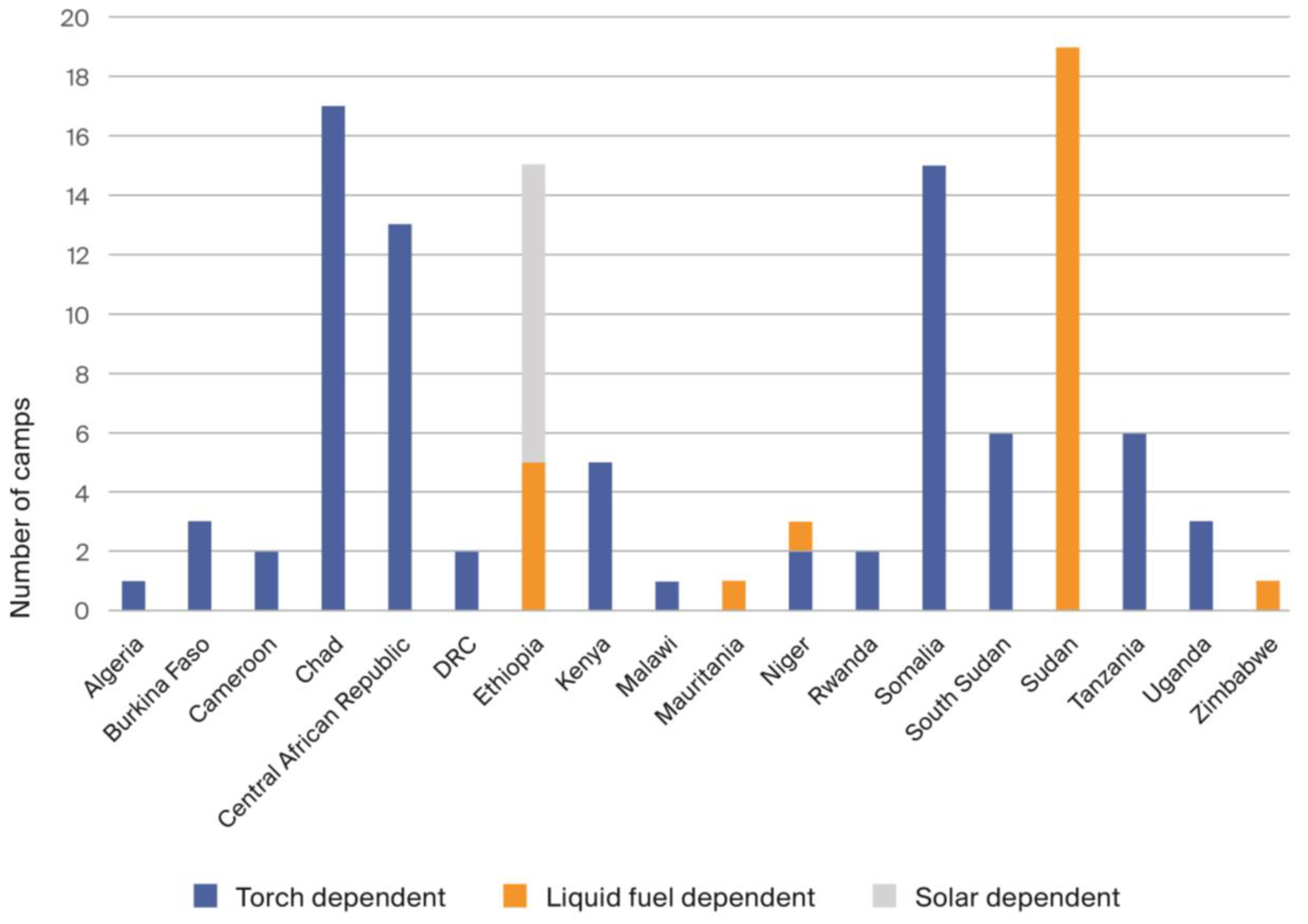
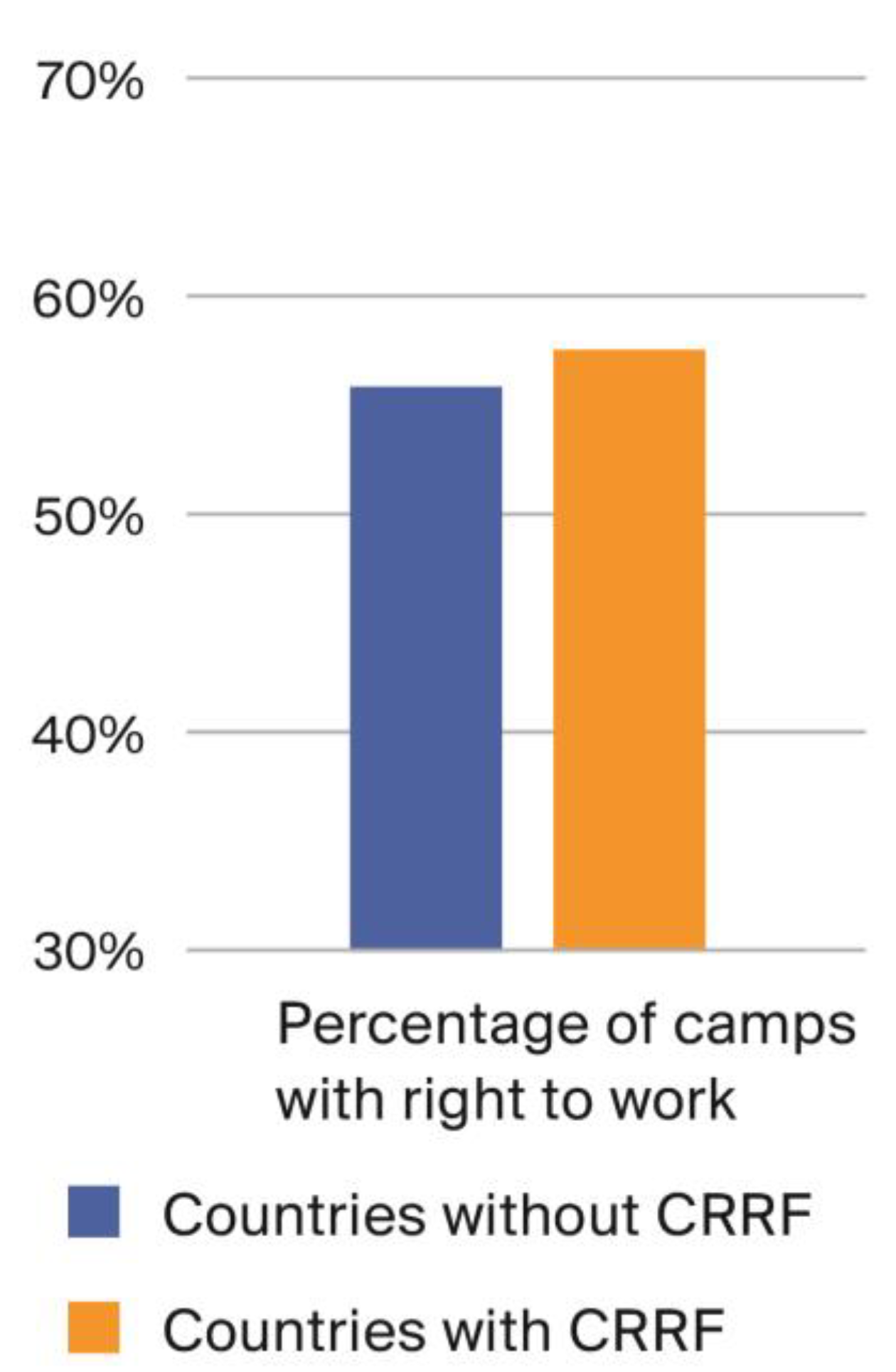
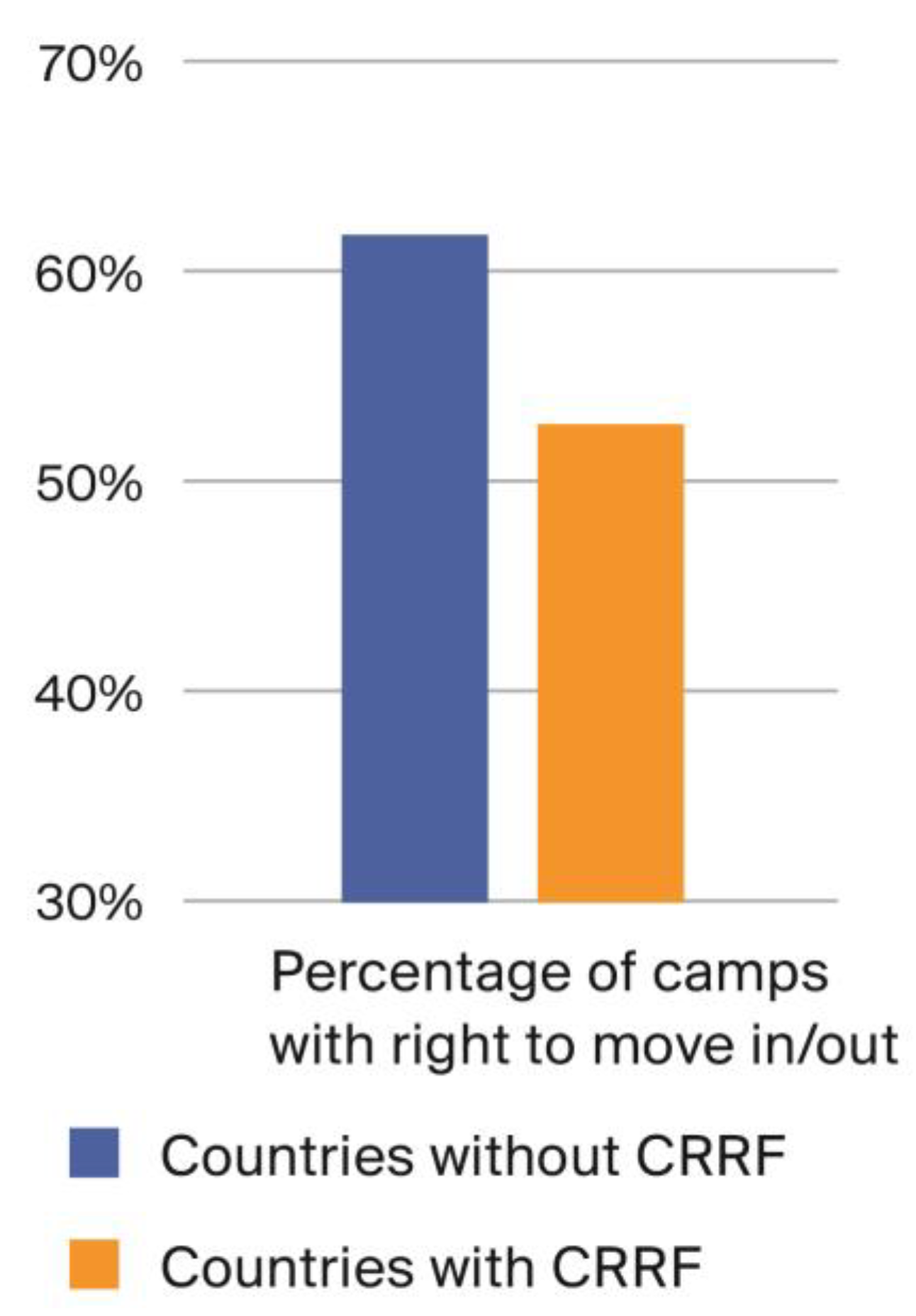
3.2.6. Project Activities on Access to Energy in Displacement Contexts
4. Discussion
4.1. Critical Reflection of the Study
4.2. Available Data on Energy Access in Displacement Contexts
4.3. Data Insights from a Country Perspective
4.4. Data Insights from a Camp Perspective
4.5. Limitations and Considerations of the Available Data
5. Conclusions
Author Contributions
Data Availability Statement
Acknowledgments
Conflicts of Interest
Appendix A
| Countries without data or a displaced population below 20000, and not in this study |
Number of displaced persons |
|---|---|
| Equatorial Guinea | no data |
| Mauritius | no data |
| Sao Tome and Principe | no data |
| Seychelles | no data |
| Cape Verde | 115 |
| Sierra Leone | 324 |
| Benin | 2639 |
| Gabon | 280 |
| Gambia | 3883 |
| Ghana | 11048 |
| Guinea | 2252 |
| Guinea-Bissau | 54 |
| Liberia | 1441 |
| Namibia | 7268 |
| Senegal | 12062 |
| Togo | 9876 |
| Tunisia | 8929 |
| Botswana | 900 |
| Comoros | 17 |
| Eritrea | 136 |
| Lesotho | 545 |
| Madagascar | 245 |
| Eswatini | 2161 |
| Morocco | 18066 |
| Tracking SDG 7 – The Energy Progress Report | ||
|---|---|---|
| Dimension | Assessment | Score |
| Timeliness | The latest publication of the Energy Progress Report is from 2022 and represents the results for the year 2021. | 1 |
| Completeness | 29 from the 30 countries that have been selected for our work have also been considered in the Energy Progress Report. | 2 |
| Accuracy | The Energy Progress Report is based on the collection of census and survey data. However, the data sources lack of information for some regions and some surveys are not updated regularly. The missing data is therefore estimated by using modelling tools (for example the nonparametric modelling). | 1 |
| Coherence | The methodology used for the creation of the data is common. The data collection is done by desk research while several modelling tools are used to fill the missing data for the creation of the dataset. The report is updated on a regular basis, allowing the resulting dataset to be compared to other sources. | 2 |
| Interpretability | The reporting source gives access to a detailed description of the methodology as well as further background information on the work. The additional information allows to interpret and use the data correctly. | 2 |
| Total score | 8 | |
| Humanitarian Energy Data Platform | ||
| Dimension | Assessment | Score |
| Timeliness | The source only mentions when the dataset was published (2020). It is not possible to calculate the number of years elapsed since the data was collected. | 0 |
| Completeness | The country coverage varies depending on the considered subject. For instance, the section “Country Market Analysis” covers 21 countries whereas the section “National Energy Data” covers 51 countries. The minimum coverage corresponds to 16 out of 30 countries that are considered in our analysis. | 0 |
| Accuracy | The dataset was created by using different sources with different levels of accuracy and methodologies (data survey and models). The reporting source states that the work does not represent a complete picture of the humanitarian energy situation but rather an overview of factors that influence the current trends of the humanitarian energy environment. | 1 |
| Coherence | The dataset is based on common methods (e.g., surveys, interviews). A comparison with sources however shows that the data is incoherent. Any interpretation deriving from the analysis of the data and any use with other sources should be done with the knowledge that the dataset is not coherent. |
1 |
| Interpretability | A description of the methodology is available. The objective of the analysis as well as the used sources and contributors are mentioned. However, the link to the data is missing which makes it difficult to find the exact data source. | 1 |
| Total score | 3 | |
| Refugee Settlements Electricity Access (RSEA) | ||
| Dimension | Assessment | Score |
| Timeliness | The dataset was published in 2021 and shows data collected in 2020. | 1 |
| Completeness | The analysis includes 21 out of the 30 countries considered in our analysis. | 0 |
| Accuracy | The dataset is based on data from existing literature (academic articles, white papers) as well as field research (surveys, interviews). The collected data was cross-referenced for consistency. | 2 |
| Coherence | The dataset was created by using common methods including desk research, field data collection and interviews with stakeholders. The reporting source has published a paper which explains the work and its purpose in detail. We have not found any incoherence in the data and therefore conclude that this source can be used in combination with other sources. | 2 |
| Interpretability | The work is described in detail in a research paper allowing a clear view on the used methodology. The purpose as well as the limitations of the work are explained so that the data can be interpreted correctly. | 2 |
| Total score | 7 | |
| UNHCR refugee data finder | ||
| Dimension | Assessment | Score |
| Timeliness | The data was published in 2023 and shows the results of the analysis for the year 2022. The dataset is updated every six months. | 2 |
| Completeness | All the countries selected for our analysis are covered by the dataset. | 2 |
| Accuracy | The work is based on different data sources which all represent real world data, including population censuses, surveys and administrative records. Statistical frameworks specifically developed for the analysis of forcibly displaced persons are used to complement the data analysis. | 2 |
| Coherence | The source uses methodologies that are common for a population count (statistical analysis based on population censuses, surveys, administrative data records, etc.). There has not been found any incoherence during our analysis of the data. | 2 |
| Interpretability | A detailed description of the used methodology is available and allows to interpret and use the data correctly. The source also gives access to further documents with detailed descriptions of the analysis that lead to the creation of the dataset. | 2 |
| Total score | 10 | |
| Regulatory Indicators for Sustainable Energy (RISE) | ||
| Dimension | Assessment | Score |
| Timeliness | The dataset was published in 2022 and represents the results for the year 2021. | 1 |
| Completeness | The source does not have the same country coverage for each section. The minimum coverage is 26 out of 30 countries considered in our analysis. | 1 |
| Accuracy | The dataset is based on desk research and field data (surveys). The reporting sources gives access to the used data sources and additional information related to the analysis. It should be noted that the results are not representing any real-world data but rather a score which is based on the specific framework that was developed for this analysis (RISE framework). A certain subjectiveness should therefore be attributed to the work which also influences its accuracy. | 1 |
| Coherence | The used methodology is explained in detail. Any incoherence in the dataset was not found. | 2 |
| Interpretability | The reporting source gives access to the methodology and further information that allows a clear understanding of what the dataset can be used for. The sources that were used for the creation of the dataset are also shared on the web page of the reporting source. | 2 |
| Total score | 7 | |
| Moving Energy Initiative | ||
| Dimension | Assessment | Score |
| Timeliness | The information was obtained from different sources with the oldest dating back to 2014. | 0 |
| Completeness | The source does not have the same country coverage for each section. The lowest coverage is 18 out of 30 countries considered in our analysis. | 0 |
| Accuracy | A scientific article was published which describes the methodology of the work in detail. It is stated that the dataset is based on a simple model which does not lead to accurate results. | 0 |
| Coherence | The dataset was created with common methods and can be used with other datasets if it is understood that the data represents more an indication than a detailed picture. The dataset shows some incoherencies (e.g., description for type of cooking fuel, see section 2 GPA UNITAR). | 1 |
| Interpretability | A detailed description of the methodology used in this work is presented in the scientific article. It is clear what the work is intended to show and how the data should be interpreted. | 2 |
| Total score | 3 | |
References
- Global Appeal 2024; UNHCR, 2024;
- Glossary on Migration; IOM;
- EMN Asylum and Migration Glossary Available online: https://home-affairs.ec.europa.eu/networks/european-migration-network-emn/emn-asylum-and-migration-glossary_en (accessed on 22 August 2023).
- UNHCR Master Glossary of Terms | UNHCR Available online: https://www.unhcr.org/glossary (accessed on 22 August 2023).
- Global Appeal 2023; UNHCR, 2023;
- Matthey-Junod, A. Leaving No Aspect of Sustainability behind: A Framework for Designing Sustainable Energy Interventions Applied to Refugee Camps. Social Science 2022.
- Bisaga, I.; To, L.S. Funding and Delivery Models for Modern Energy Cooking Services in Displacement Settings: A Review. Energies 2021, 14, 4176. [CrossRef]
- Jacobsen, K. The Forgotten Solution: Local Integration for Refugees in Developing Countries; UN High Commissioner for Refugees (UNHCR), 2001; p. 43.
- Brause, U. Analysis of Empowerment of Refugee Women in Camps and Settlements. The Journal Internal Displacement 2013.
- Moore, B. Refugee Settlements and Sustainable Planning. 2017.
- Damme, W.V. How Liberian and Sierra Leonean Refugees Settled in the Forest Region of Guinea (1990-96). Journal of Refugee Studies 1999, 12, 36–53. [CrossRef]
- Thomas, P.J.M.; Rosenberg-Jansen, S.; Jenks, A. Moving beyond Informal Action: Sustainable Energy and the Humanitarian Response System. Int J Humanitarian Action 2021, 6, 21. [CrossRef]
- Rosenberg-Jansen, S. The Secret Life of Energy in Refugee Camps: Invisible Objects, Technologies, and Energy Systems in Humanitarianism. Journal of Refugee Studies 2022, 35, 1270–1291. [CrossRef]
- Home | Sustainable Development Available online: https://sdgs.un.org/ (accessed on 21 March 2024).
- Accelerating SDG7 Achievement: Policy Briefs in Support of the First SDG7 Review at the UN High-Level Political Forum; United Nations, 2018.
- Dr Sarah Rosenberg-Jansen and Dr Hajar Al-Kaddo.; Contributing authors: Joelle Hangi, Thomas Fohgrub, Elif Demir, Owen; Grafham, Eva Mach, Luc Severi, Mark Gibson, Mattia Vianello, Laura Clarke,; Cathleen Seeger, Aimee Jenks, Lama Gharaibeh, Cecilia Ragazzi, Iwona; Bisaga, Jonathan Archimi, Philip Sandwell, Stephen Gitonga, David Kinzuzi,; Arielle Ben-Hur, Vahid Jahangiri, Surabhi Rajagopal, Ziad Ayad, and Sadiq; Zafrullah. The State of the Humanitarian Energy Sector: Challenges, Progress and Issues in 2022; UNITAR Publishing: Geneva, Switzerland, 2022.
- Barbieri, J.; Leonforte, F.; Colombo, E. Towards an Holistic Approach to Energy Access in Humanitarian Settings: The SET4food Project from Technology Transfer to Knowledge Sharing. Int J Humanitarian Action 2018, 3, 11. [CrossRef]
- Rosenberg-Jansen, S. Inclusive Energy Solutions in Refugee Camps. Nature Energy 2019, 4.
- Thomas, P.J.M.; Sandwell, P.; Williamson, S.J.; Harper, P.W. A PESTLE Analysis of Solar Home Systems in Refugee Camps in Rwanda. Renewable and Sustainable Energy Reviews 2021, 143, 110872. [CrossRef]
- Robinson, B.L.; Halford, A.; Gaura, E. From Theory to Practice: A Review of Co-Design Methods for Humanitarian Energy Ecosystems. Energy Research & Social Science 2022, 89, 102545n Methods for Humanitarian Energy Ecosystems. [CrossRef]
- Baldi, D.; Moner-Girona, M.; Fumagalli, E.; Fahl, F. Planning Sustainable Electricity Solutions for Refugee Settlements in Sub-Saharan Africa. Nat Energy 2022, 7, 369–379. [CrossRef]
- How Night-Time Street Lighting Affects Refugee Communities; UNHCR, 2017.
- Renewables for Refugee Settlements: Sustainable Energy Access in Humanitarian Situations.
- Rosenberg-Jansen, S. The Emerging World of Humanitarian Energy: A Conceptual Research Review. Energy Research & Social Science 2022, 92, 102779. [CrossRef]
- Africa Energy Outlook 2022.
- Bhatia, M., A., N. Beyond Connections: Energy Access Redefined; Energy Sector Management Assistance Program (ESMAP): Washington, D.C., 2015.
- Pelz, S.; Pachauri, S.; Groh, S. A Critical Review of Modern Approaches for Multidimensional Energy Poverty Measurement. WIREs Energy & Environment 2018, 7, e304. [CrossRef]
- Abdelnour, S.; Pemberton-Pigott, C.; Deichmann, D. Clean Cooking Interventions: Towards User-Centred Contexts of Use Design. Energy Research & Social Science 2020, 70, 101758. [CrossRef]
- Neves, D.; Baptista, P.; Pires, J.M. Sustainable and Inclusive Energy Solutions in Refugee Camps: Developing a Modelling Approach for Energy Demand and Alternative Renewable Power Supply. Journal of Cleaner Production 2021, 298, 126745. [CrossRef]
- Robinson, B.L.; Clifford, M.J.; Jewitt, S. TIME to Change: Rethinking Humanitarian Energy Access. Energy Research & Social Science 2022, 86, 102453. [CrossRef]
- Bellanca, R. Sustainable Energy Provision Among Displaced Populations: Policy and Practice. Policy and Practice.
- Baranda Alonso, J.; Sandwell, P.; Nelson, J. The Potential for Solar-Diesel Hybrid Mini-Grids in Refugee Camps: A Case Study of Nyabiheke Camp, Rwanda. Sustainable Energy Technologies and Assessments 2021, 44, 101095. [CrossRef]
- Lehne, J.; Blyth, W.; Lahn, G.; Bazilian, M.; Grafham, O. Energy Services for Refugees and Displaced People. Energy Strategy Reviews 2016, 13–14, 134–146. [CrossRef]
- Fuentes, M.; Vivar, M.; Hosein, H.; Aguilera, J.; Muñoz-Cerón, E. Lessons Learned from the Field Analysis of PV Installations in the Saharawi Refugee Camps after 10 Years of Operation. Renewable and Sustainable Energy Reviews 2018, 93, 100–109. [CrossRef]
- Van Hove, E.; Johnson, N.G. Refugee Settlements in Transition: Energy Access and Development Challenges in Northern Uganda. Energy Research & Social Science 2021, 78, 102103. [CrossRef]
- Maalim, S.A.; Adwek, G.; Arowo, M. Shared Energy Parks as a Solution to Energy Challenges for Dadaab Refugee Camps in Kenya. Scientific African 2021, 13, e00901. [CrossRef]
- Thomas, P.J.M.; Williamson, S.J.; Harper, P.W. The Diffusion of Solar Home Systems in Rwandan Refugee Camps. Energy for Sustainable Development 2021, 63, 119–132. [CrossRef]
- Rafa, N.; To, T.T.V.; Gupta, M.; Uddin, S.M.N. The Pursuit of Energy in Refugee Contexts: Discrimination, Displacement, and Humanitarian Energy Access for the Rohingya Refugees Displaced to Bangladesh. Energy Research & Social Science 2022, 83, 102334. [CrossRef]
- Owen Grafham Energy Access and Forced Migration; 2020.
- Grafham, O.; Sandwell, P. Harness Better Data to Improve Provision of Humanitarian Energy. Nat Energy 2019, 4, 993–996. [CrossRef]
- The Global Plan of Action for Sustainable Energy Solutions in Situations of Displacement: Framework for Action; UNITAR, 2019.
- Frercksen, N. Inclusion of Displaced Persons in National Systems.
- Yaron Cohen, L.P. Innovative Financing for Humanitarian Energy Interventions; Chatham House, 2019.
- UNHCR Energy Information System Available online: https://eis.unhcr.org/home (accessed on 22 March 2024).
- READS Programme | Global Platform for Action Available online: https://www.humanitarianenergy.org/thematic-working-areas/reads-programme/ (accessed on 22 March 2024).
- Humanitarian Data Exchange Available online: https://data.humdata.org/ (accessed on 22 March 2024).
- Rosenberg-Jansen, D.S. Critical Concepts and Research Needs in Humanitarian Energy. 2021.
- Halford, A.; Gaura, E.; Bhargava, K.; Verba, N.; Brusey, J.; Nixon, J. Off the Boil? The Challenges of Monitoring Cooking Behaviour in Refugee Settlements. Energy Research & Social Science 2022, 90, 102603. [CrossRef]
- UNHCR Refugee Data Finder 2023.
- Watts, S.; Shankaranarayanan, G.; Even, A. Data Quality Assessment in Context: A Cognitive Perspective. Decision Support Systems 2009, 48, 202–211. [CrossRef]
- Cichy, C.; Rass, S. An Overview of Data Quality Frameworks. IEEE Access 2019, 7, 24634–24648. [CrossRef]
- World Health Organization Data Quality Review: Module 1: Framework and Metrics; World Health Organization: Geneva, 2017; ISBN 978-92-4-151272-5.
- Mumbere, O.; Kopi, L. How to Conduct a Data Quality Assessment (DQA): An Aif Memoir for a COR/AOR; USAID, 2012.
- Batini, C.; Cappiello, C.; Francalanci, C.; Maurino, A. Methodologies for Data Quality Assessment and Improvement. ACM Comput. Surv. 2009, 41, 1–52. [CrossRef]
- Cameron, Laurie Methodology for Evaluating Data Quality. Working Paper WP-07-02. 2005.
- Introduction to Humanitarian Energy Data Platform 1.0 | Global Platform for Action Available online: https://www.humanitarianenergy.org/news/latest/introduction-to-humanitarian-energy-data-platform-1.0 (accessed on 23 March 2024).
- Tracking SDG 7 | Progress Towards Sustainable Energy Available online: https://trackingsdg7.esmap.org/ (accessed on 23 March 2024).
- Moving Energy Initiative - Humanitarian Data Exchange Available online: https://data.humdata.org/organization/moving-energy-initiative (accessed on 23 March 2024).
- Joint Research Centre Data Catalogue - Refugee Settlements Electricity Access (RSEA) - European Commission Available online: https://data.jrc.ec.europa.eu/dataset/4261bf3c-7e8e-4b16-925b-68cfd4eade37 (accessed on 23 March 2024).
- Grafham, O.; Lahn, G.; Haselip, J. Scaling Sustainable Energy Services for Displaced People and Their Hosts: How Policy and Governance Make a Difference; Royal Institute of International Affairs, 2022.
- RISE Available online: https://rise.esmap.org/ (accessed on 23 March 2024).
- UNHCR Refugee Data Finder Available online: https://www.unhcr.org/refugee-statistics/ (accessed on 22 March 2024).
- World Population Prospects - Population Division - United Nations Available online: https://population.un.org/wpp/ (accessed on 23 March 2024).
- From Commitment to Action - Highlight Os Progress towards Comprehensive Refugee Response; UNHCR, 2018.
- Binder, A.; Koddenbrock, K.; Horváth, A. Reflections on the Inequities of Humanitarian Assistance.
- Dong, K.; Jiang, Q.; Liu, Y.; Shen, Z.; Vardanyan, M. Is Energy Aid Allocated Fairly? A Global Energy Vulnerability Perspective. World Development 2024, 173, 106409. [CrossRef]
- Renewable Energy for Refugees; Practical Action, 2021.
- Energy Solutions for Displacement Settings (ESDS); Deutsche Gesellschaft für Internationale Zusammenarbeit, 2022.
- Berke, T.; Larsen, L. Using Land to Promote Refugee Self-Reliance in Uganda. Land 2022, 11, 410. [CrossRef]
- Humanitarian Energy: Energy for Micro-Enterprises in Displacement Settings; Deutsche Gesellschaft für Internationale Zusammenarbeit, 2020.
- Gunning, R. The Current State of Sustainable Energy Provision for Displaced Populations: An Analysis.
- Rosenberg-Jansen 1, S.; Barlow, M.; Peisch, S.; Ponnan, N.; Rathi 2, P. Sustainable Humanitarian Energy Services: Inclusive Participation, Lessons Learnt, and Paths Forward; Practical Action Publishing Ltd.: The Schumacher Centre, Bourton on Dunsmore, Rugby, Warwickshire CV23 9QZ, UK, 2018; ISBN 978-1-85339-982-4.
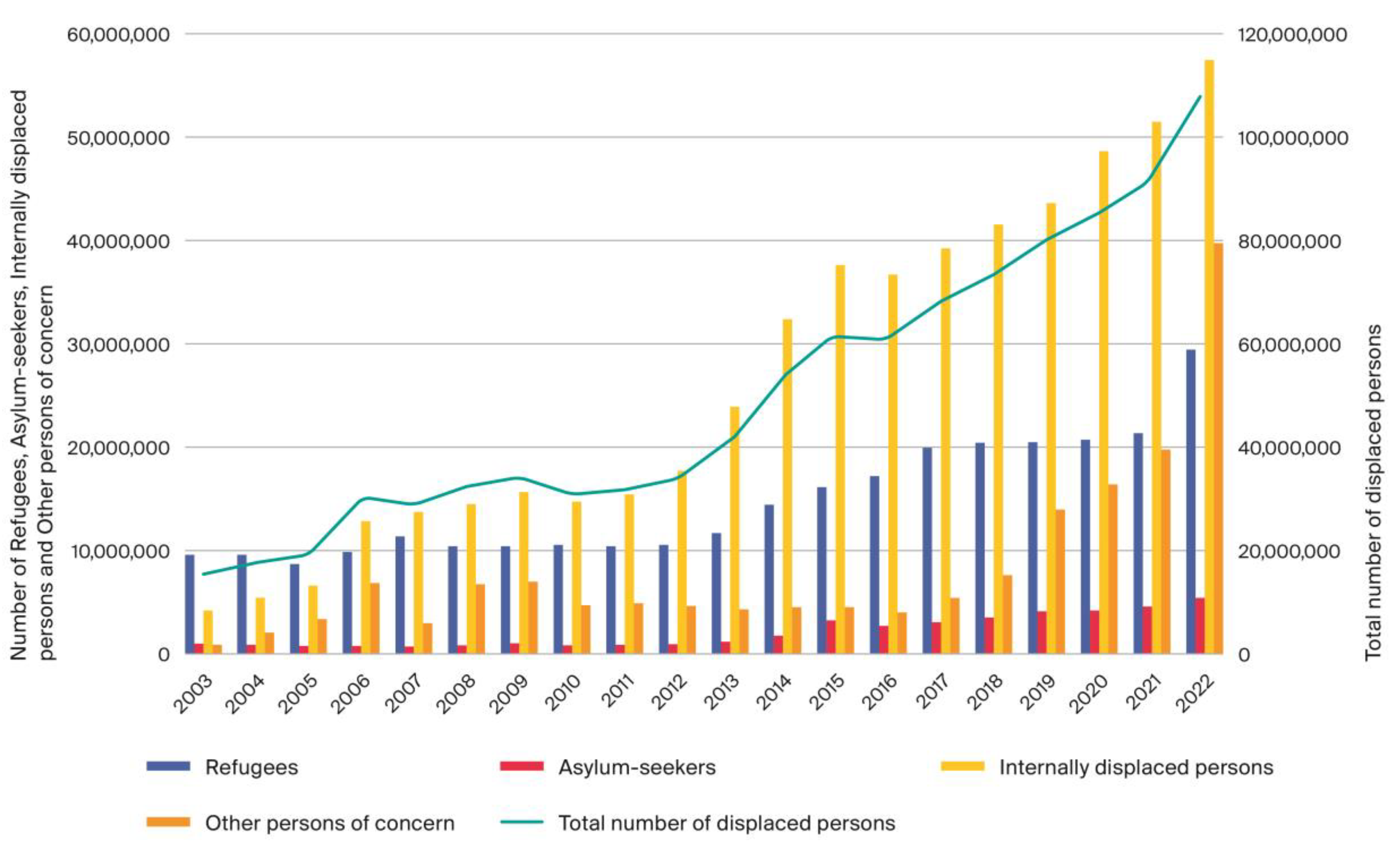
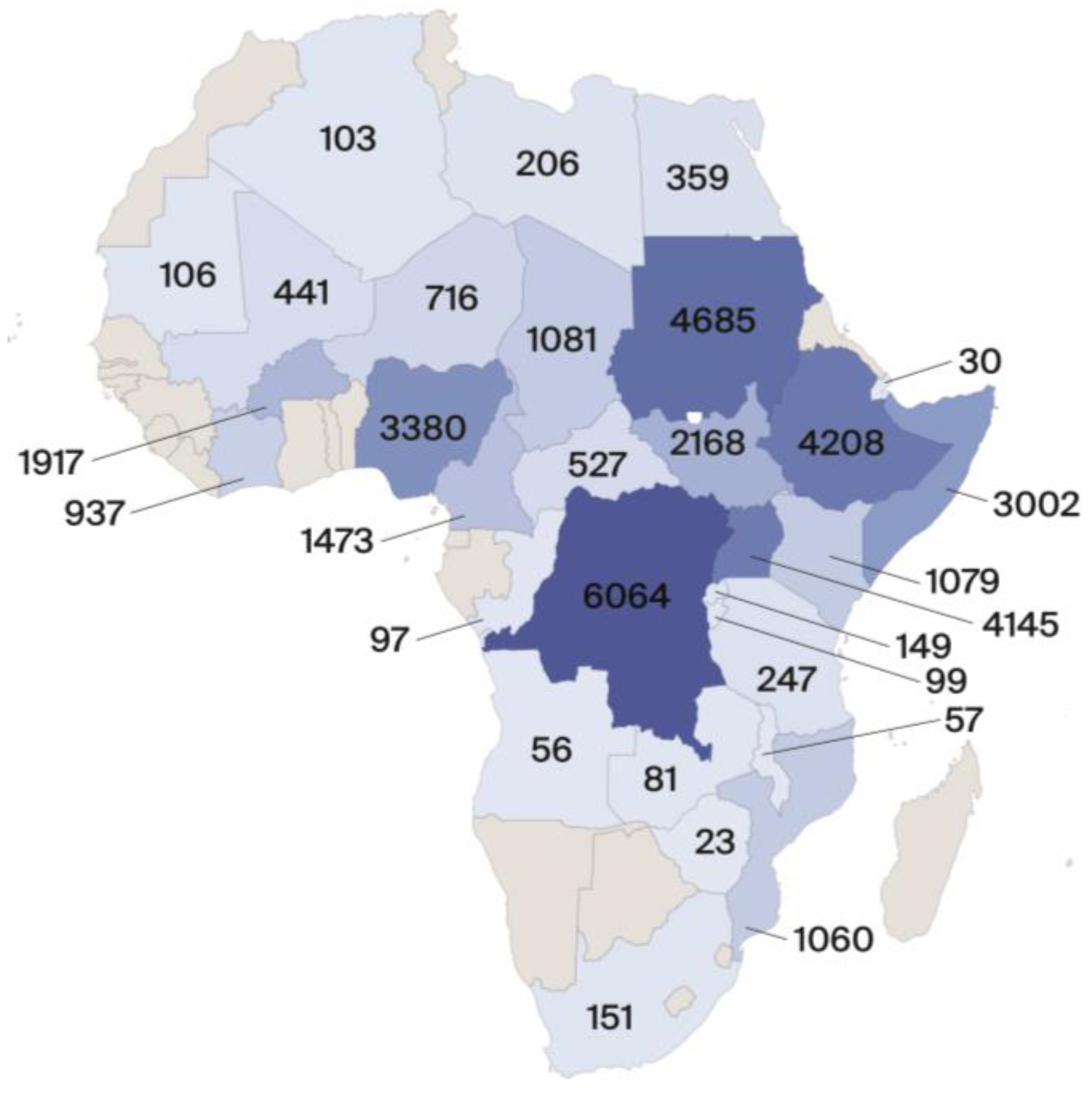
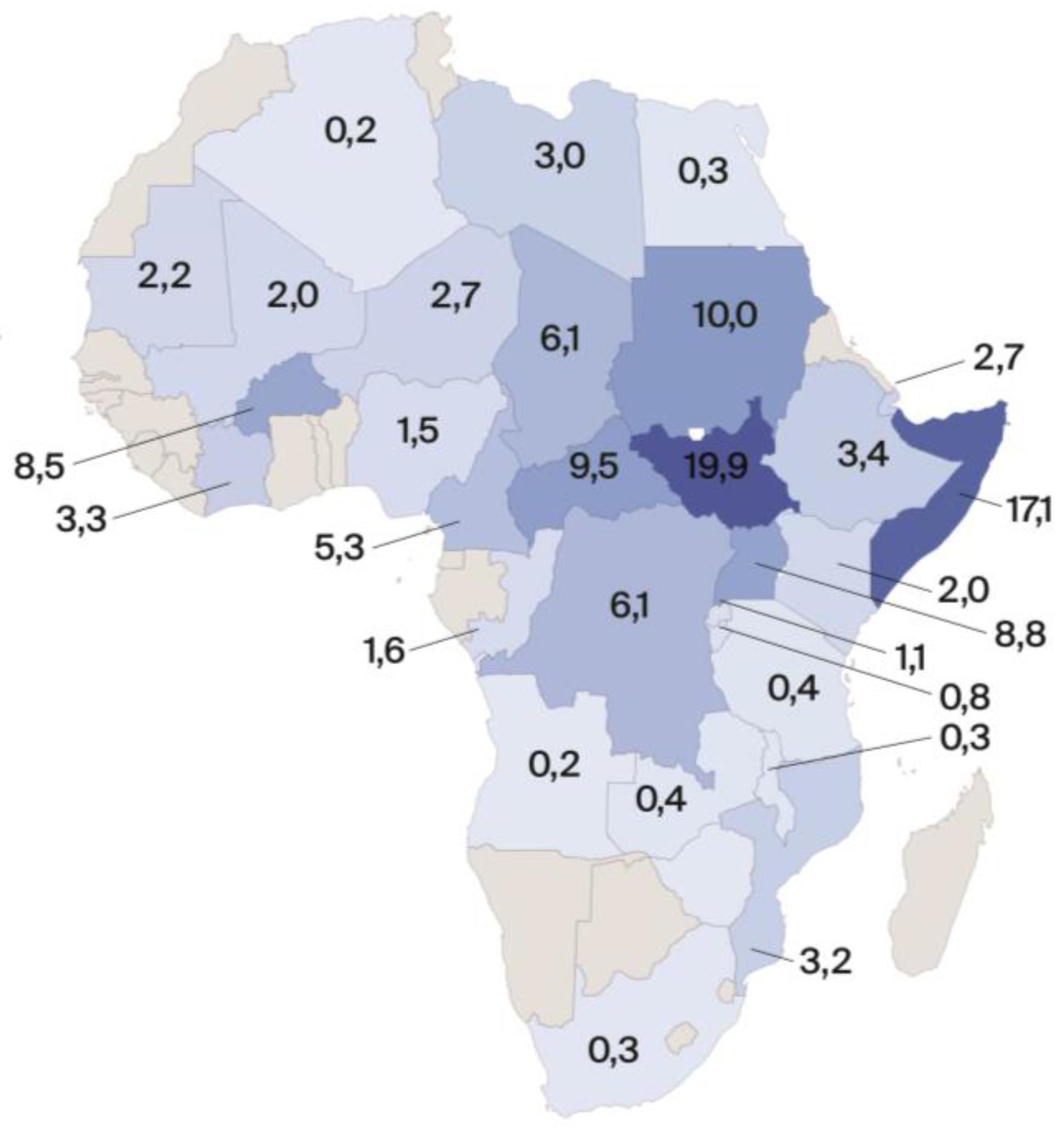
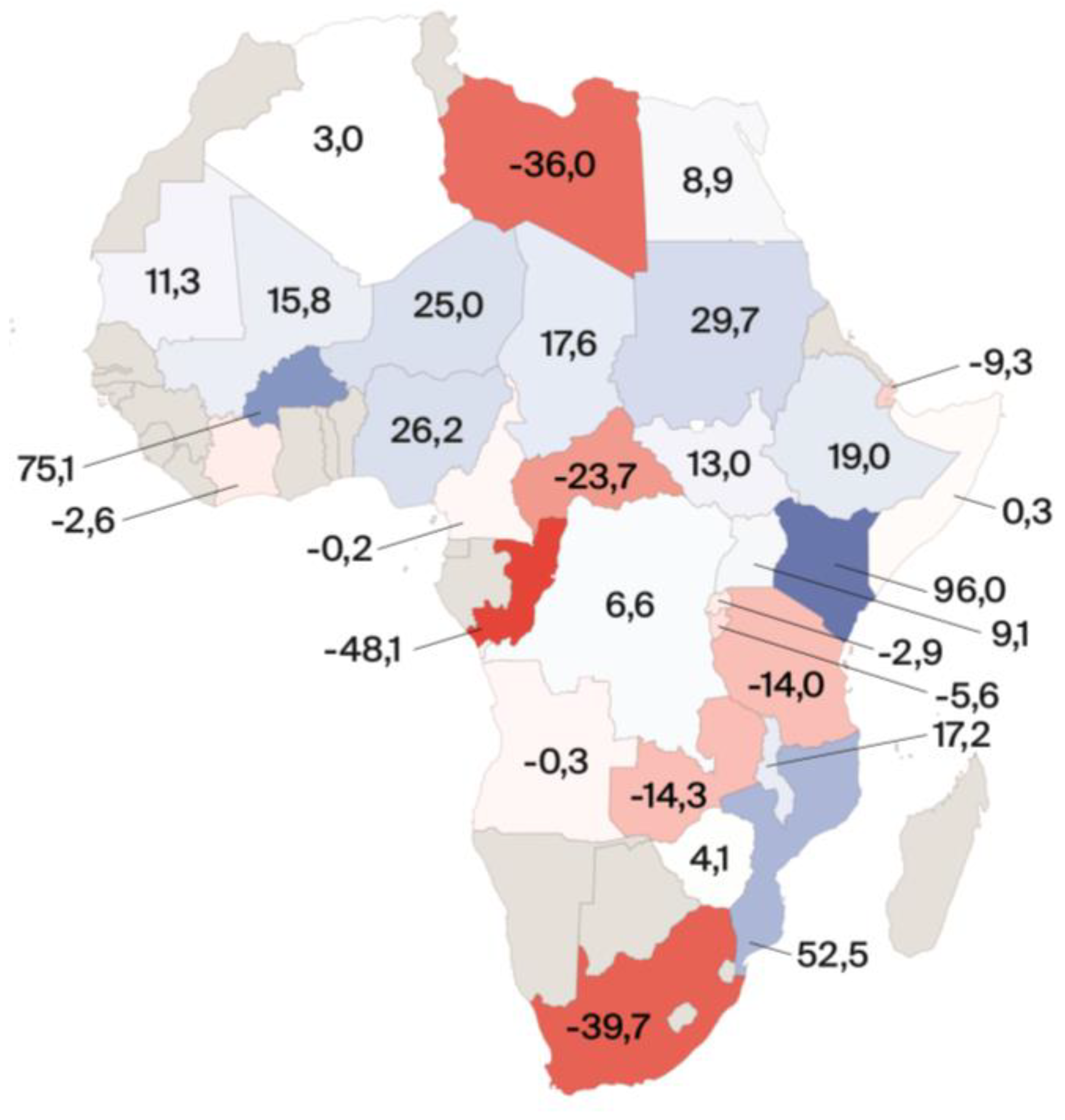
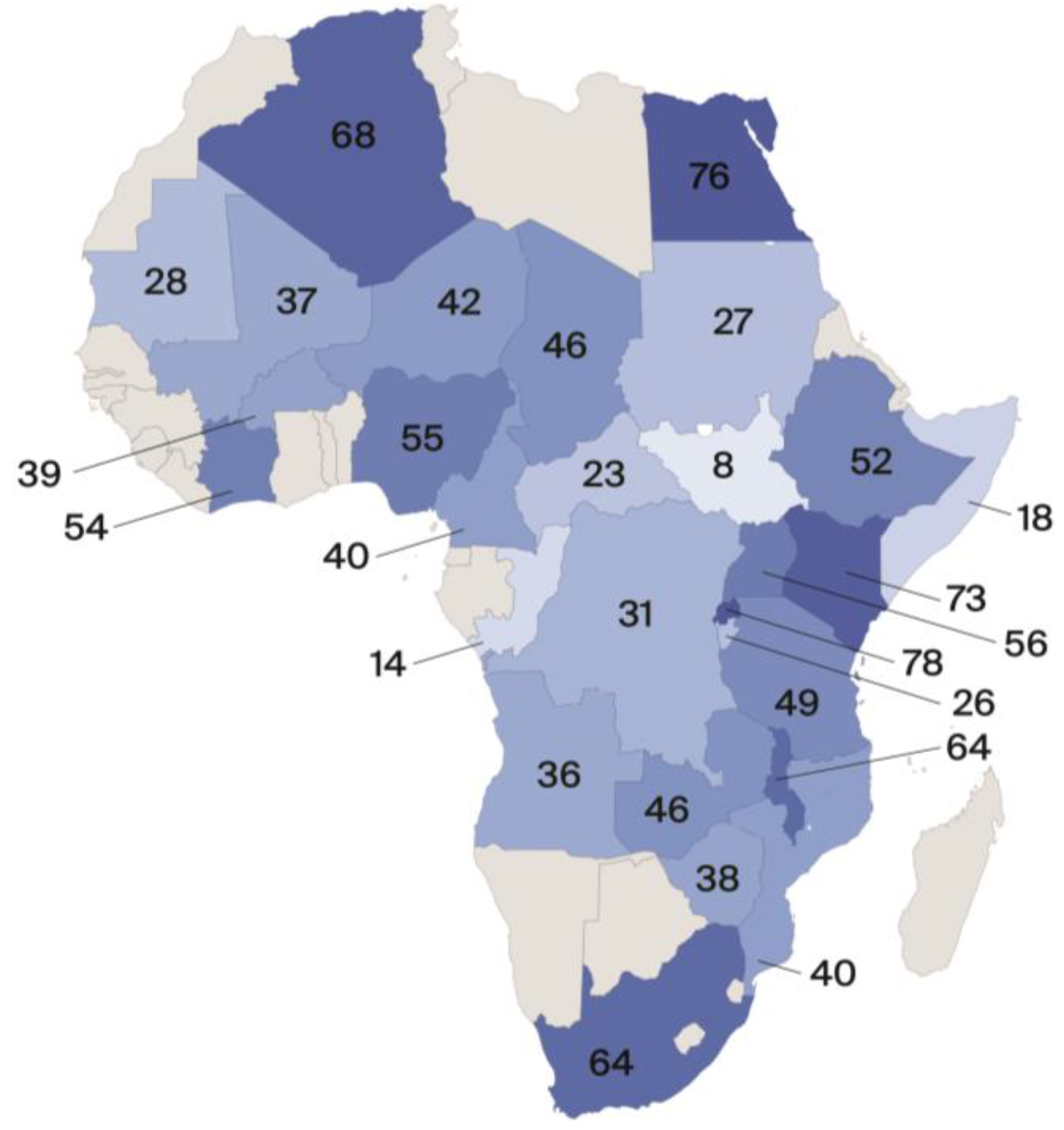
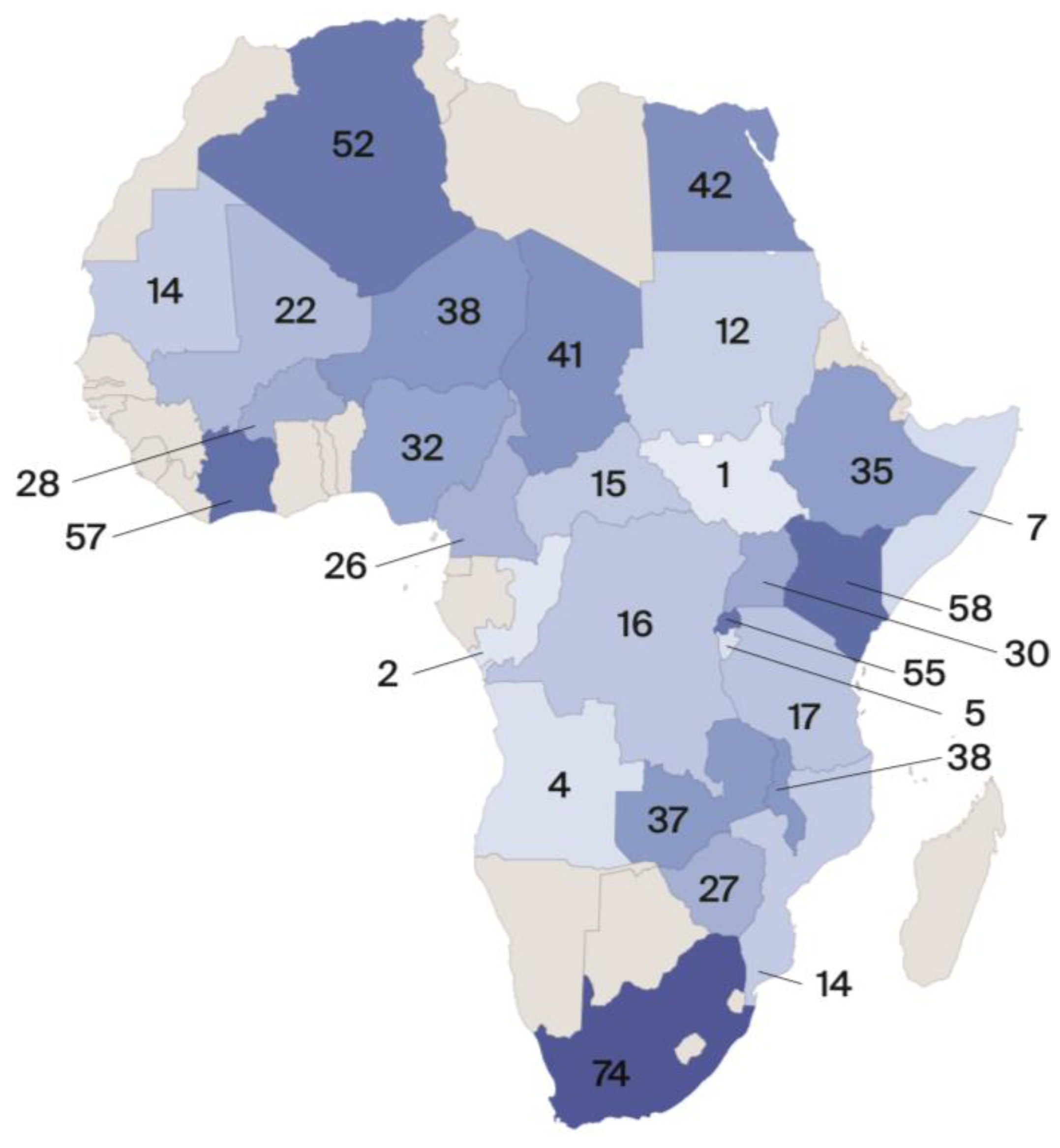
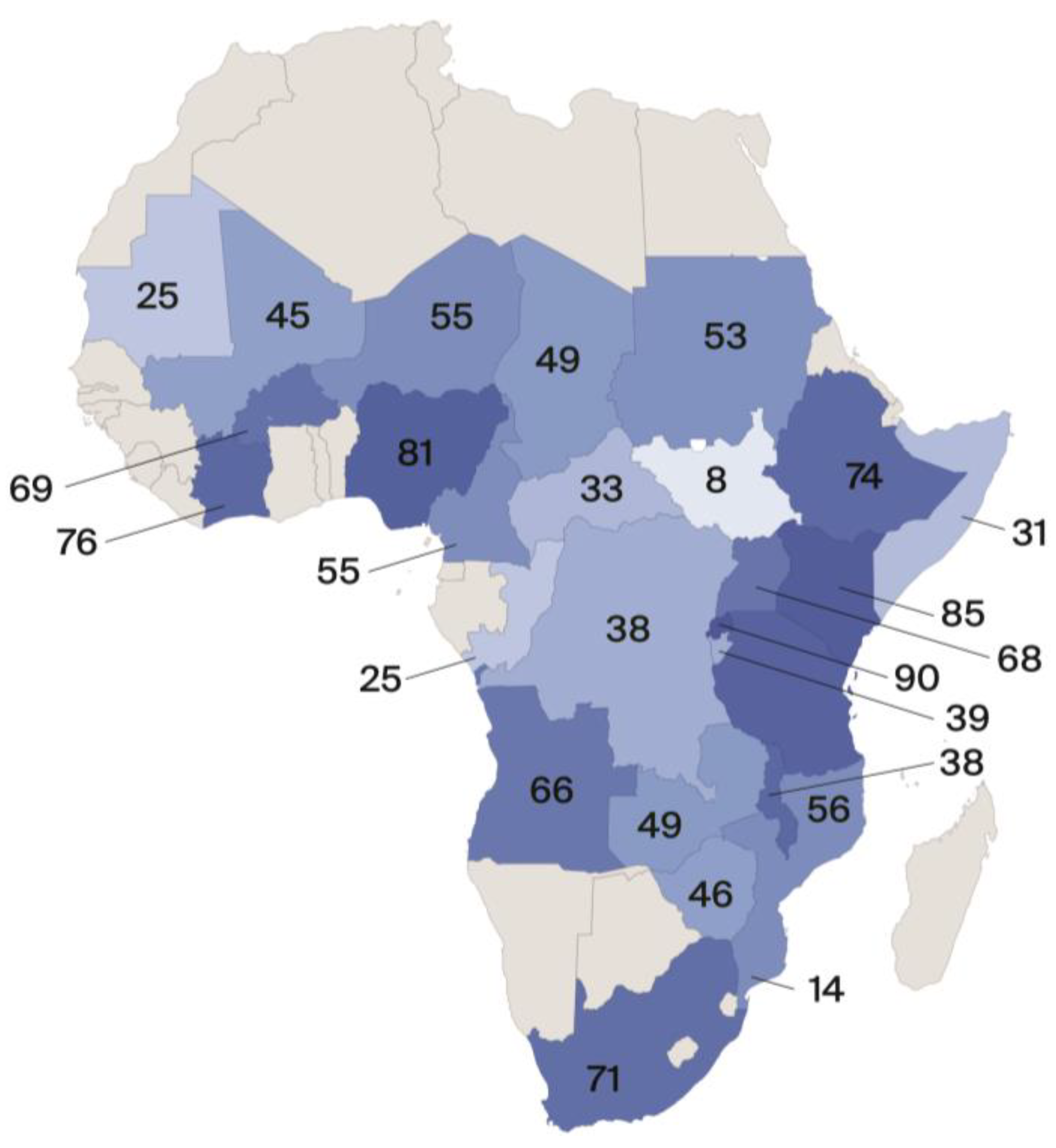
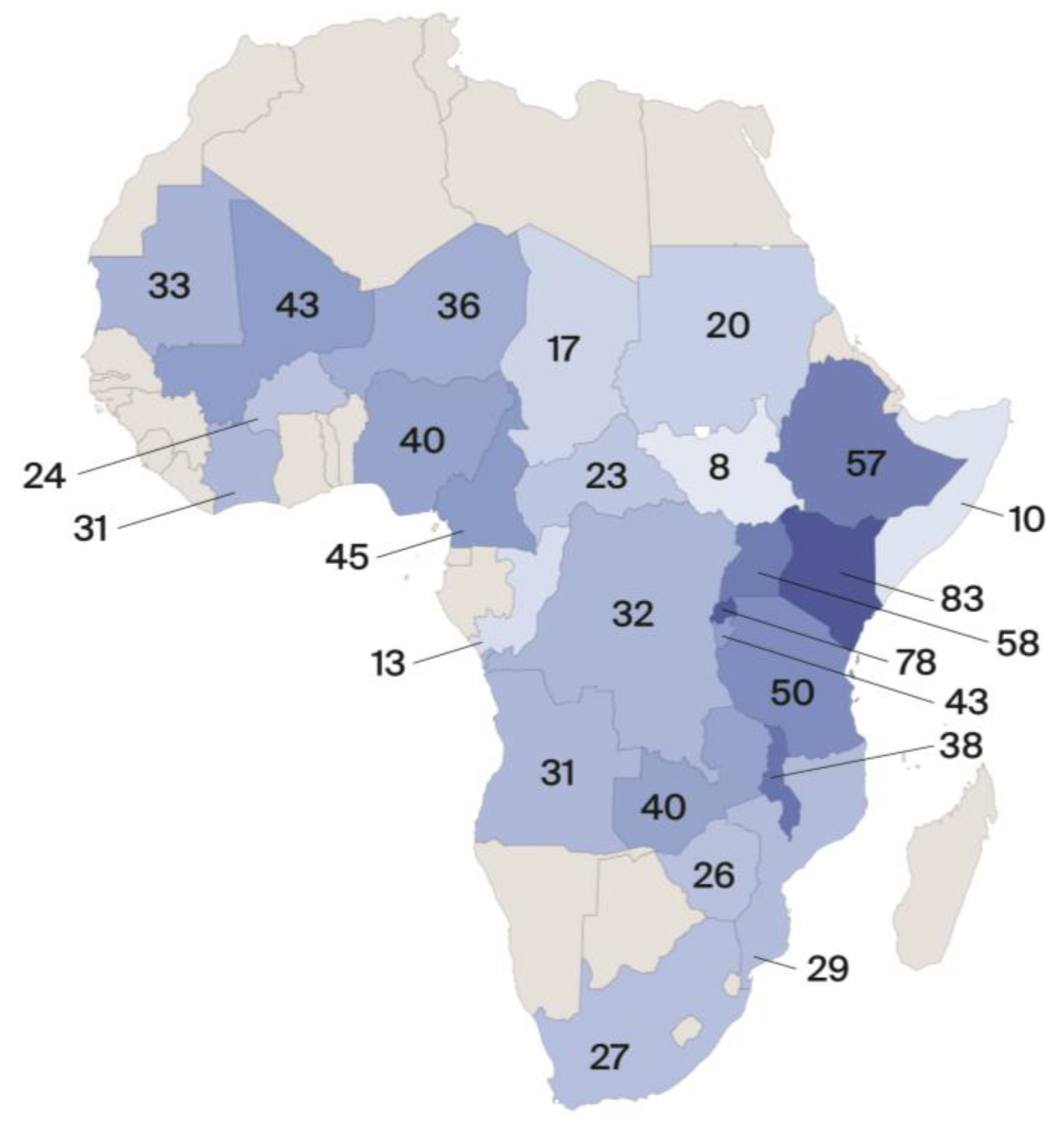
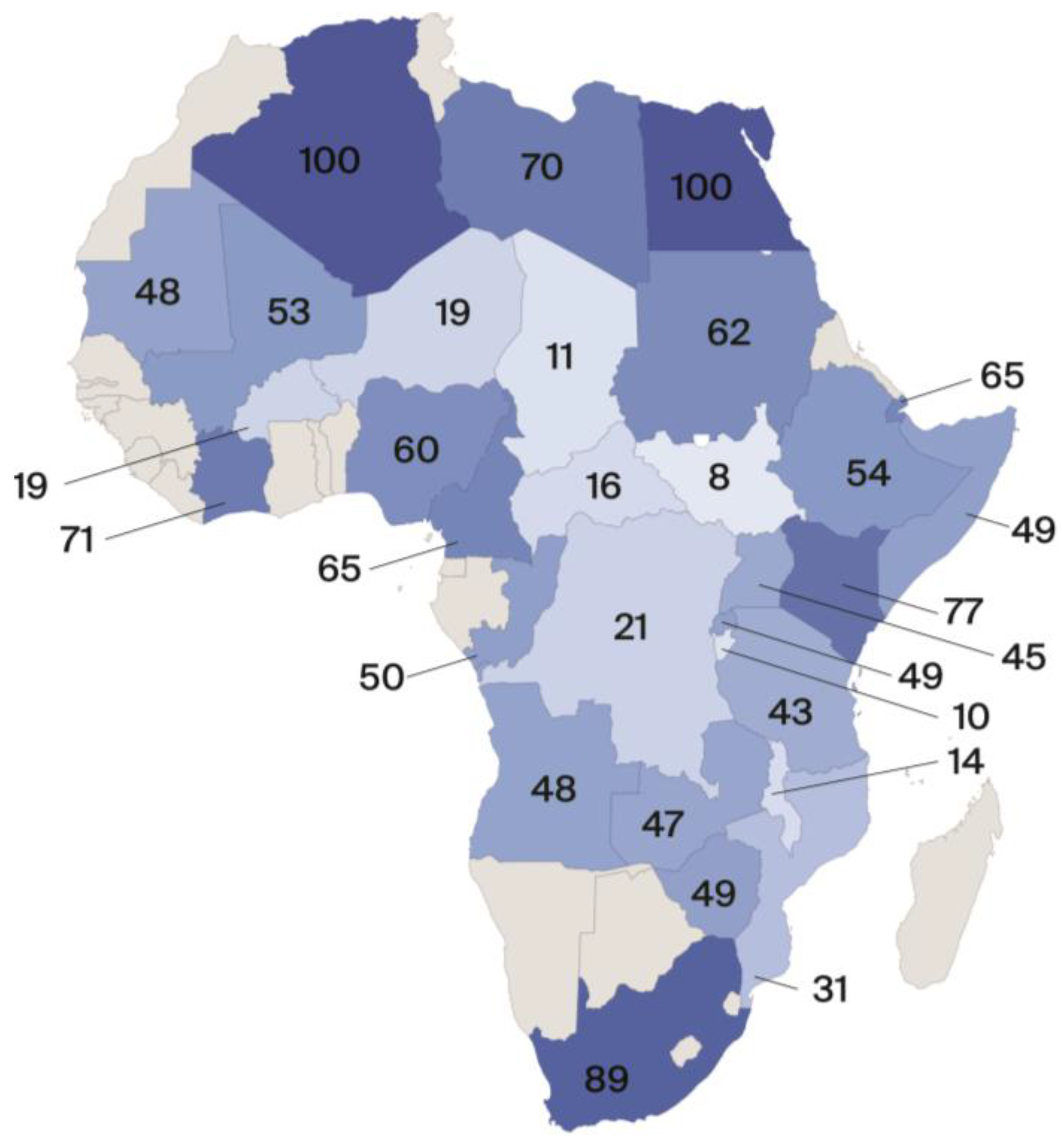
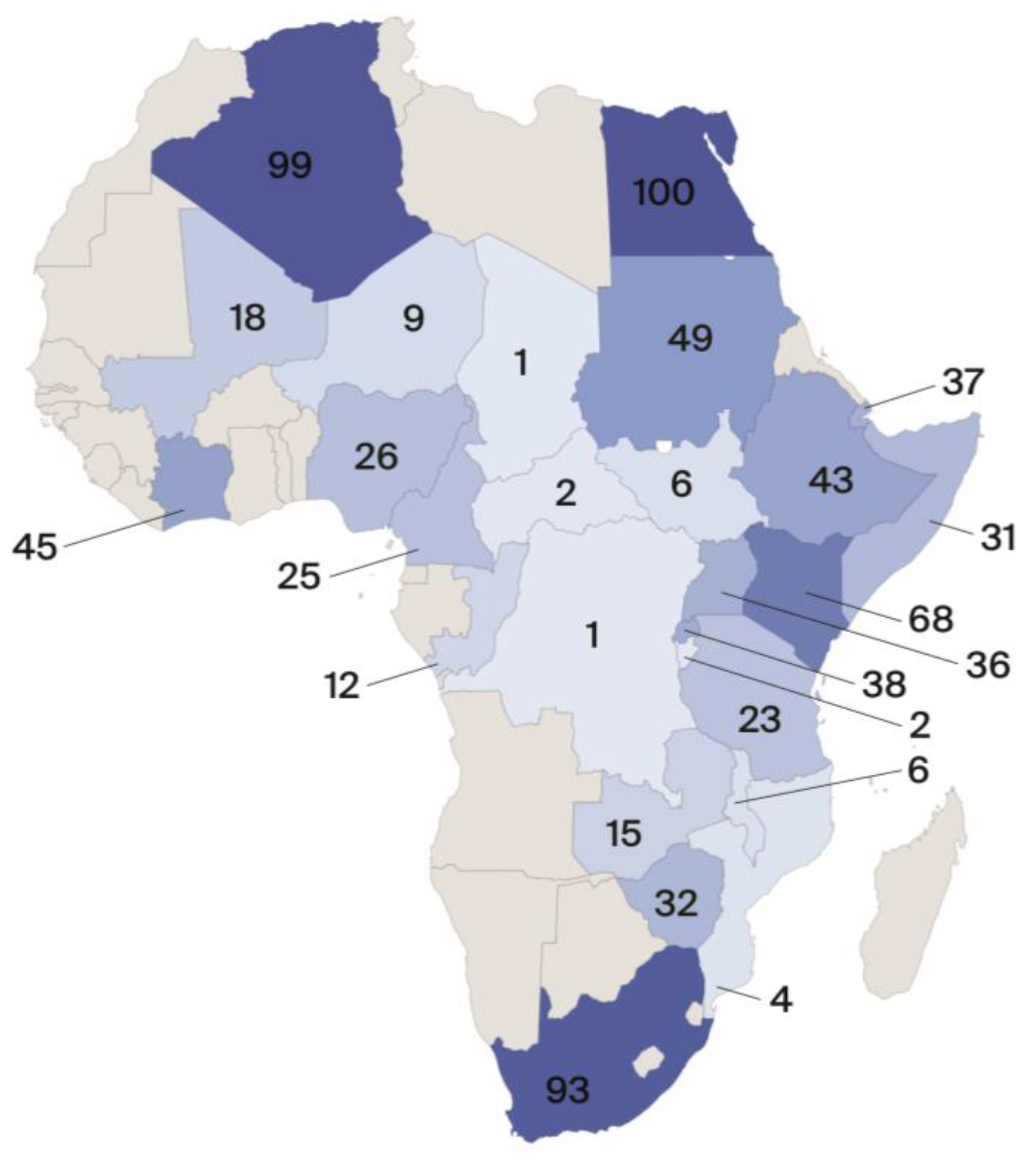
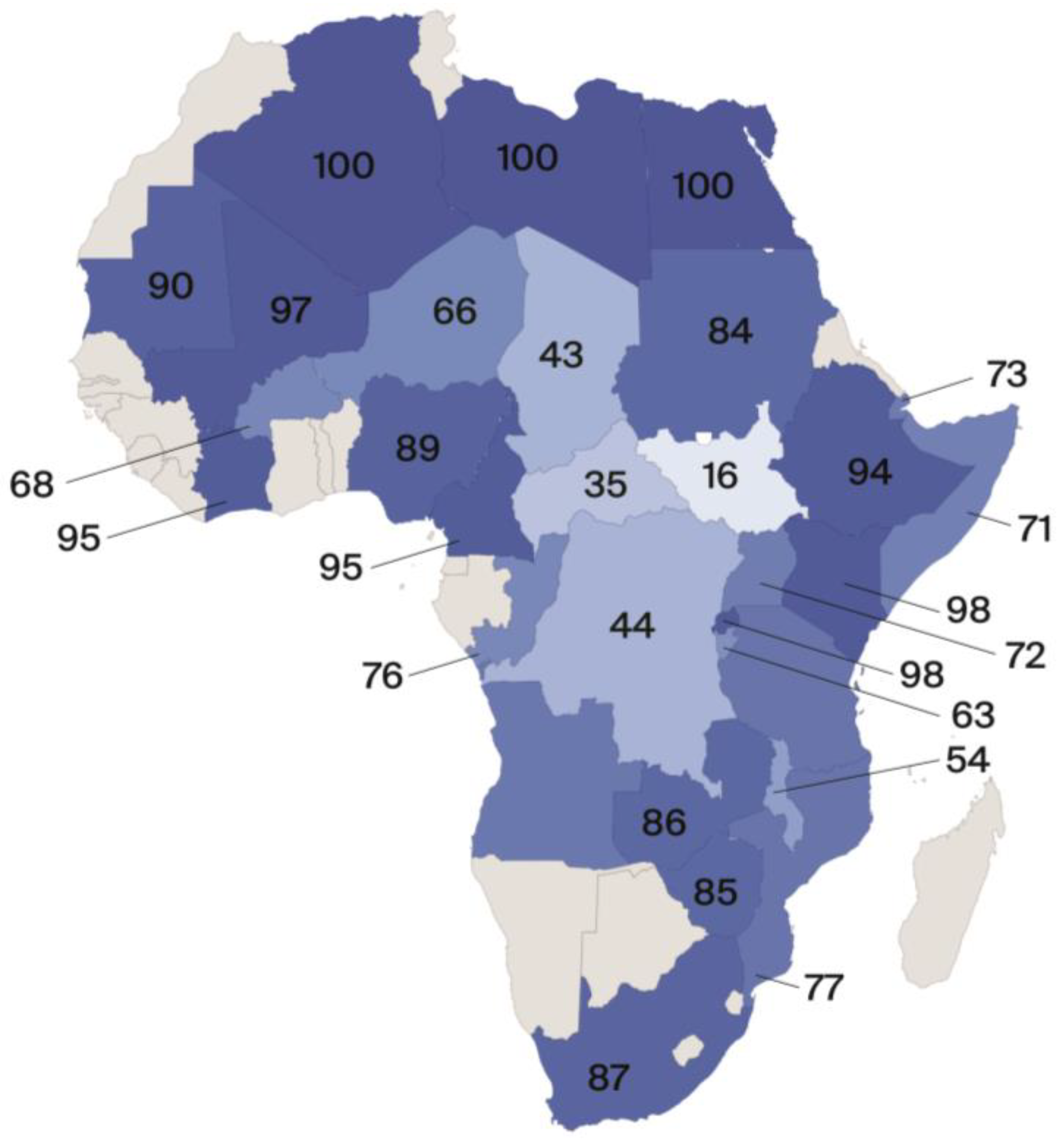
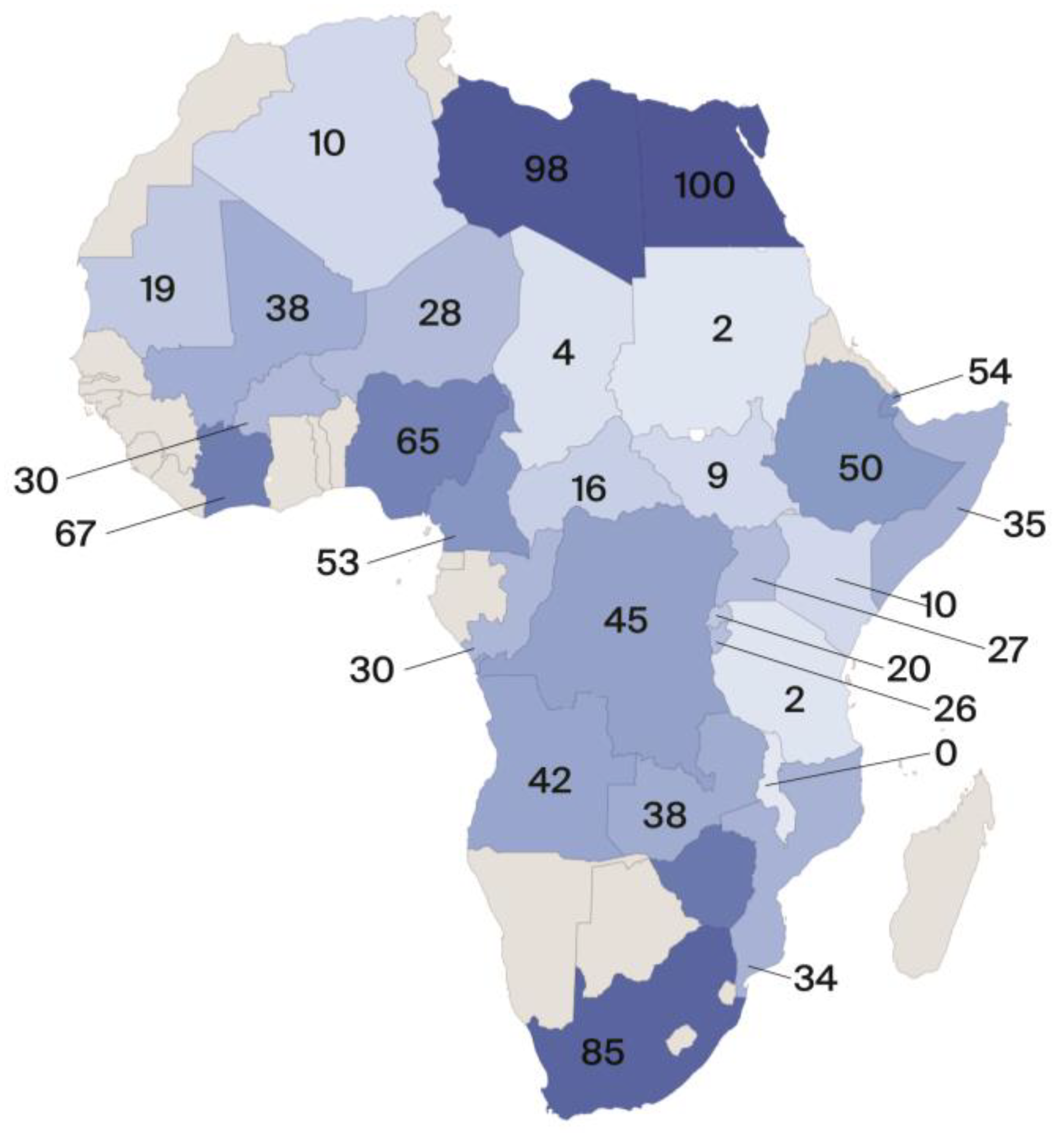
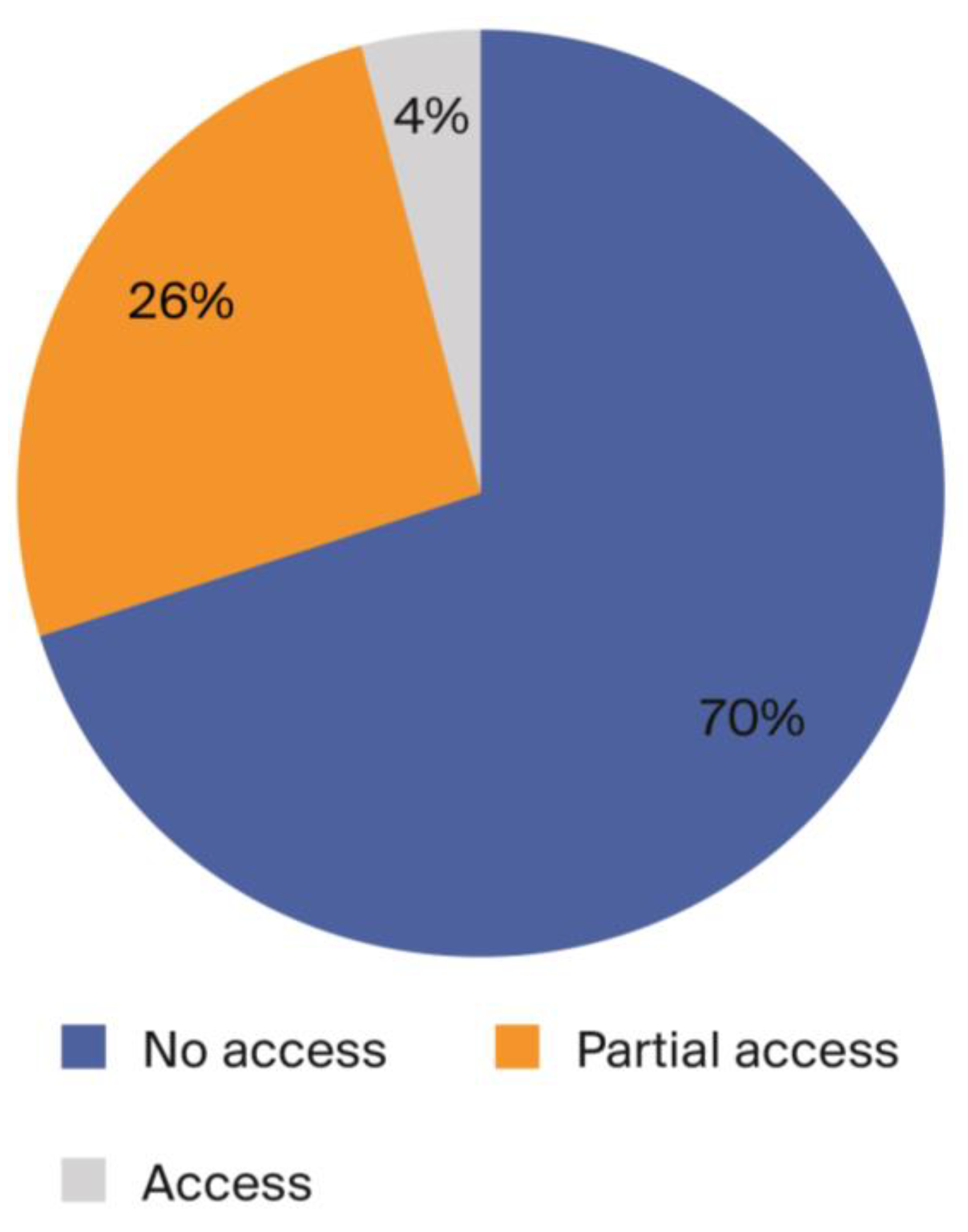
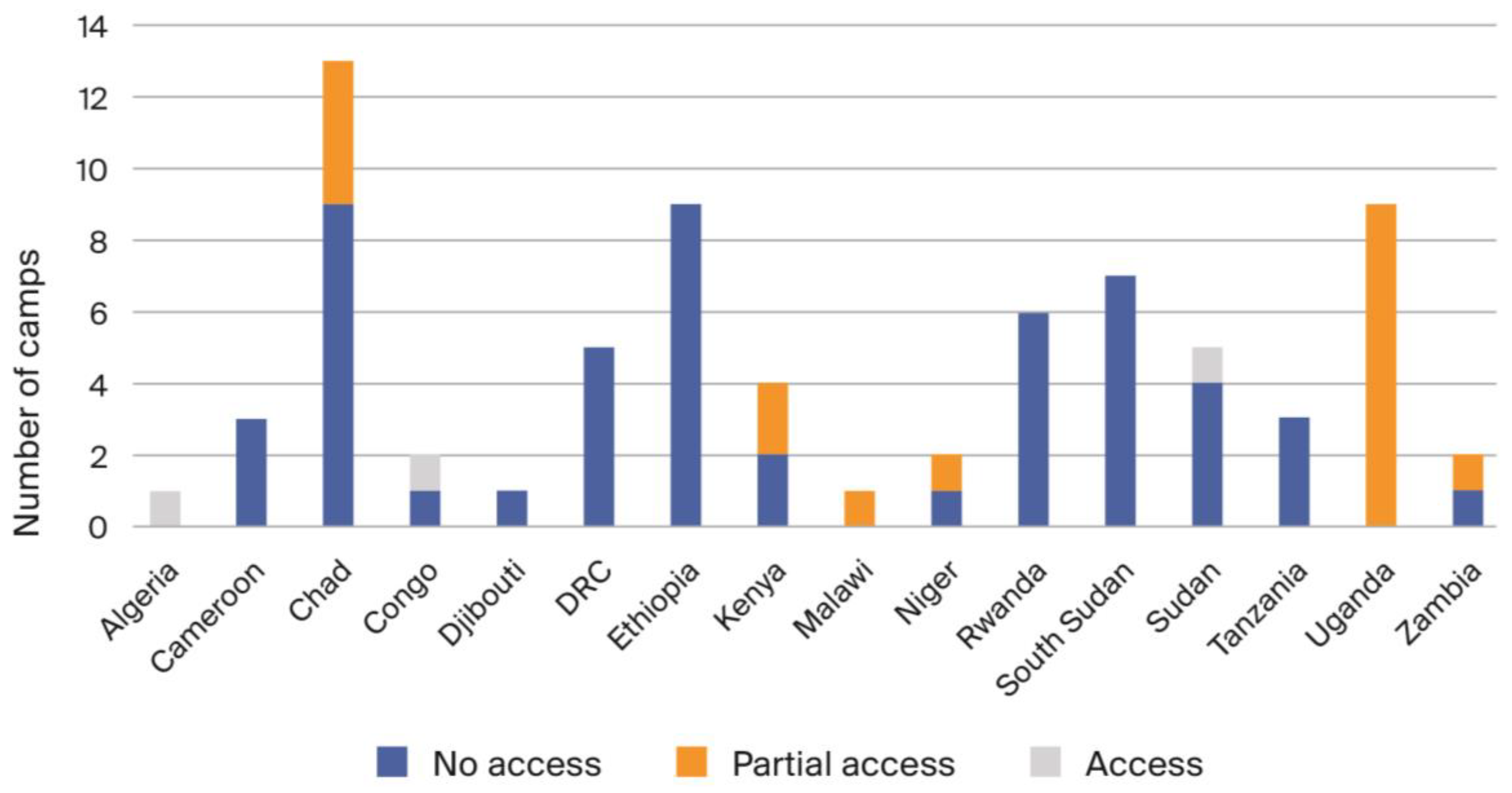
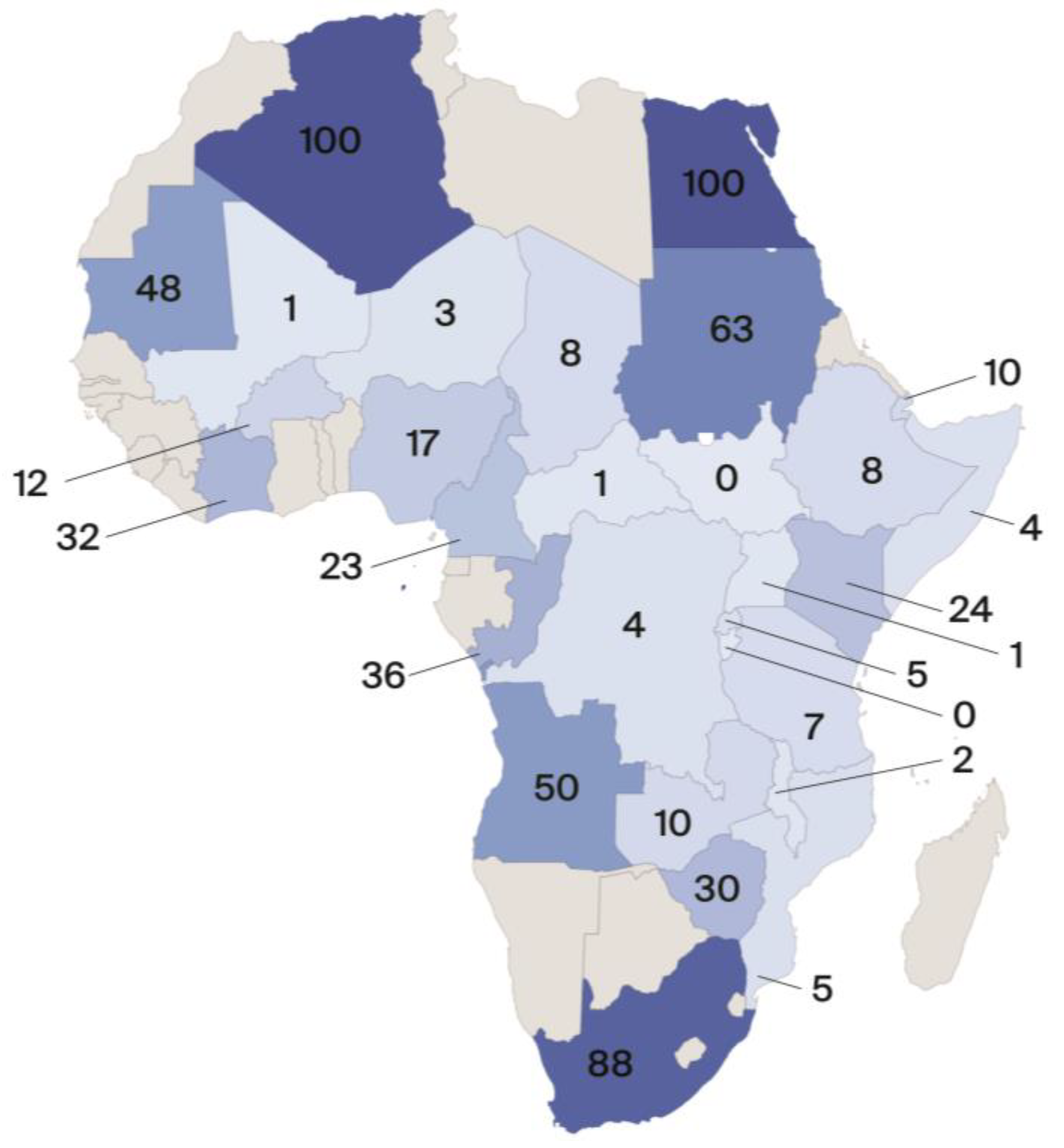
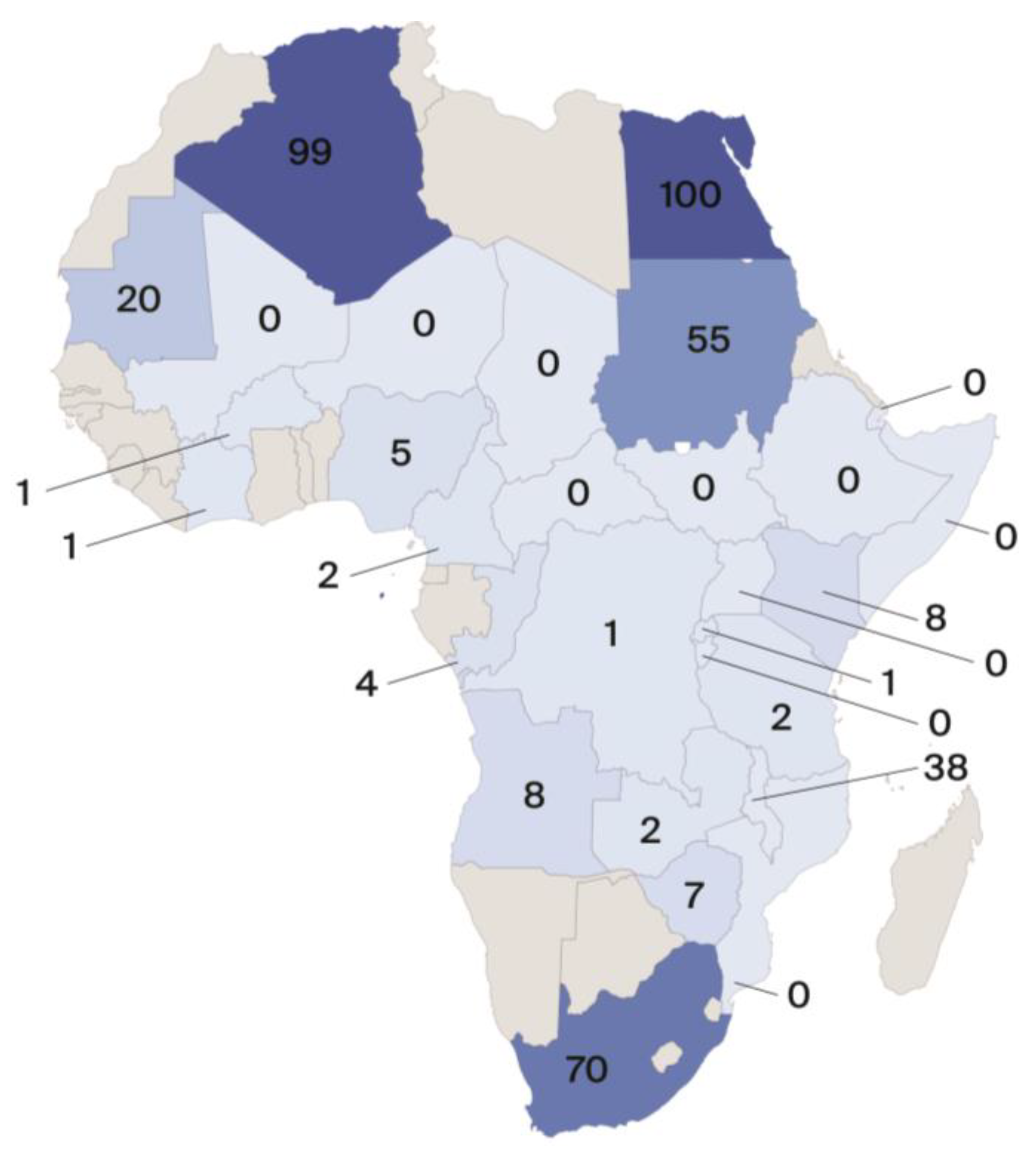
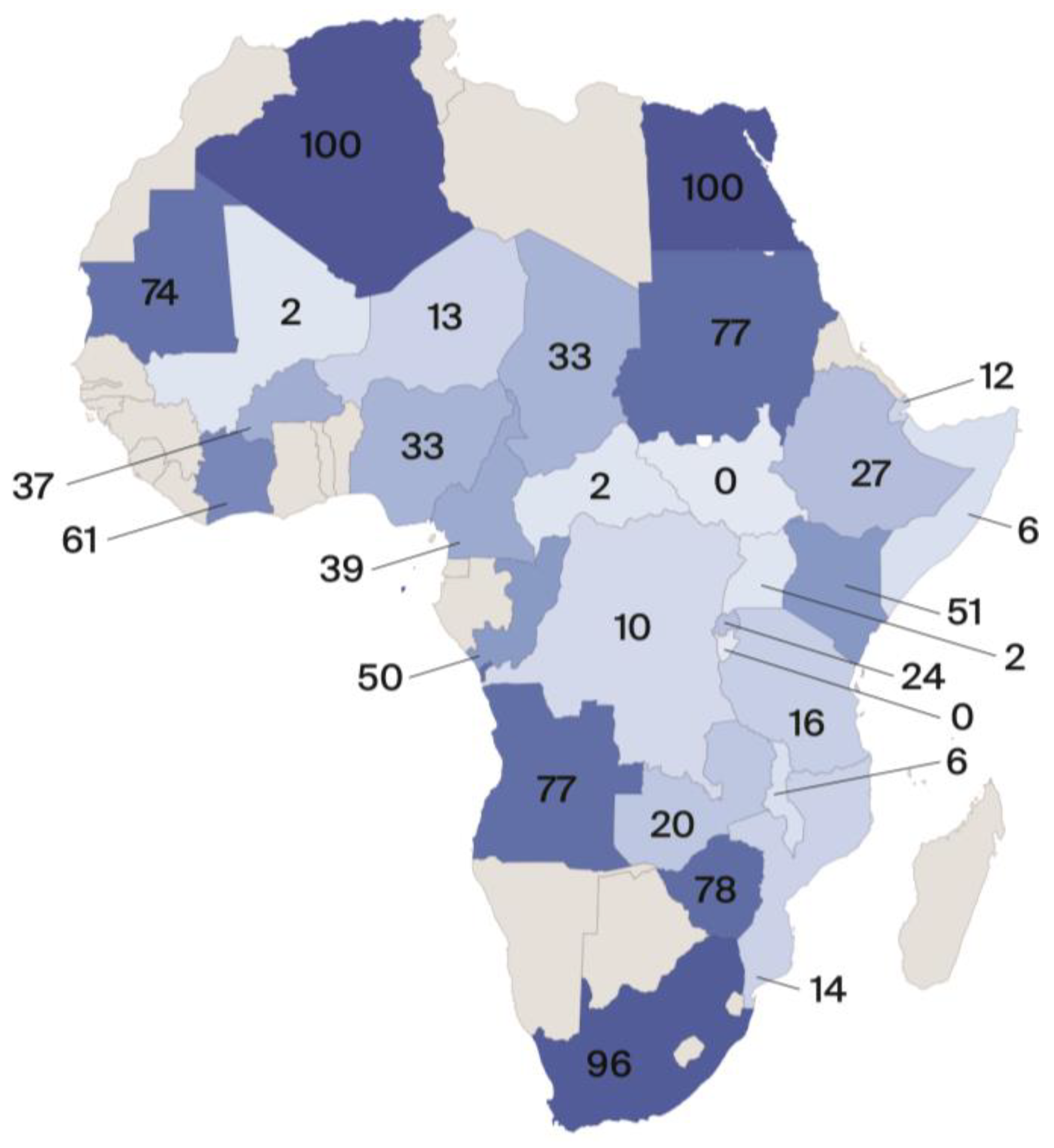
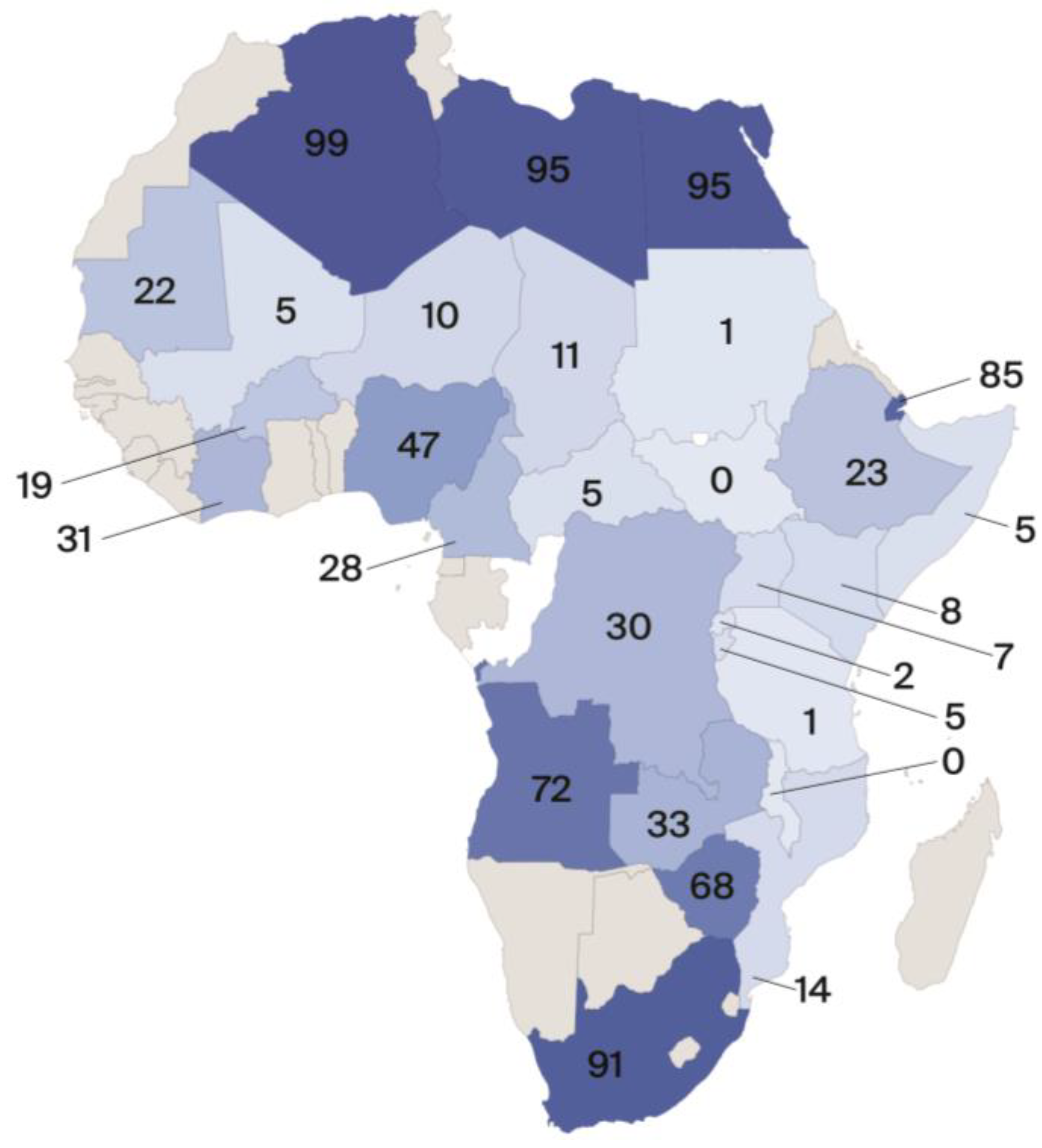
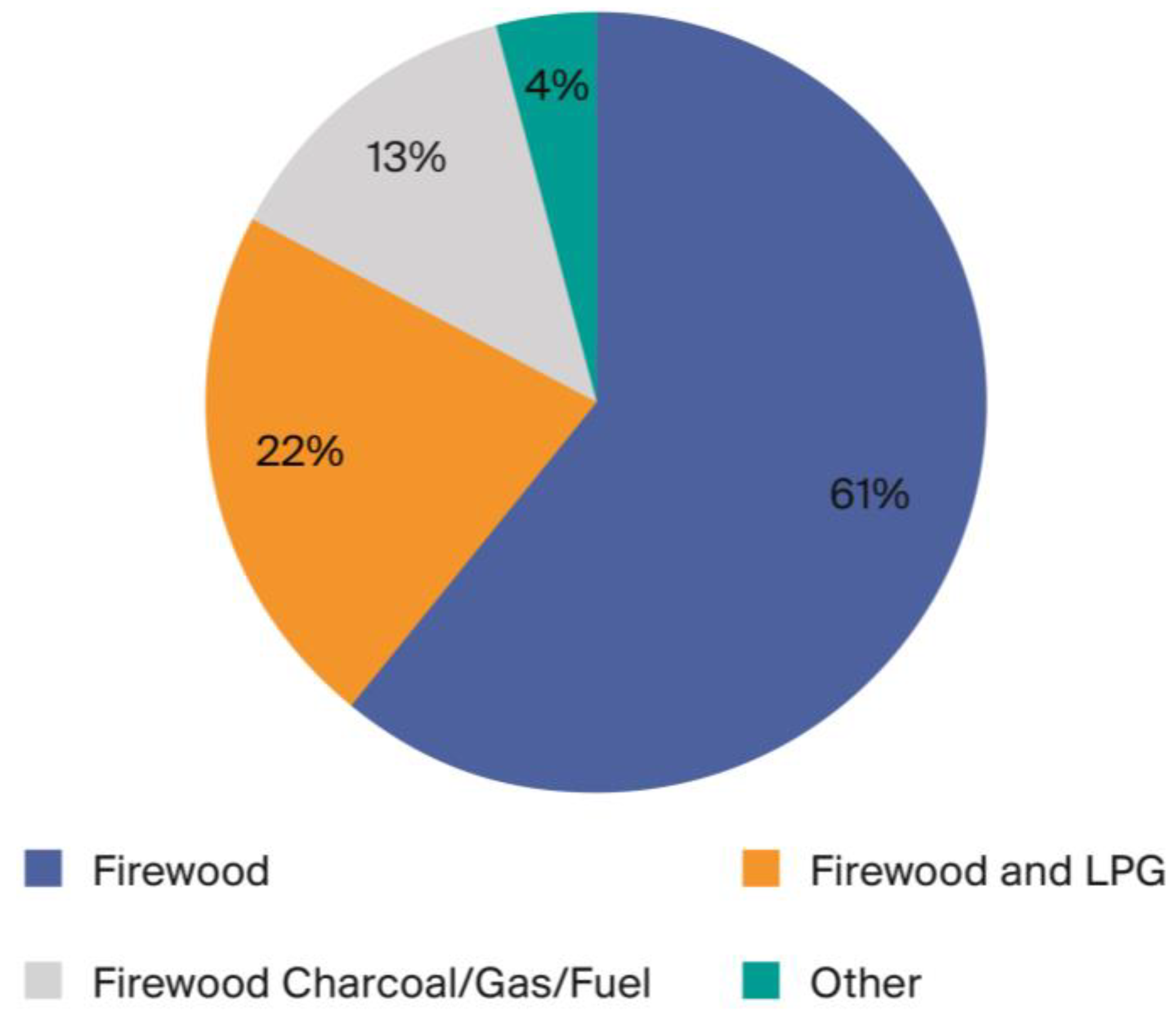
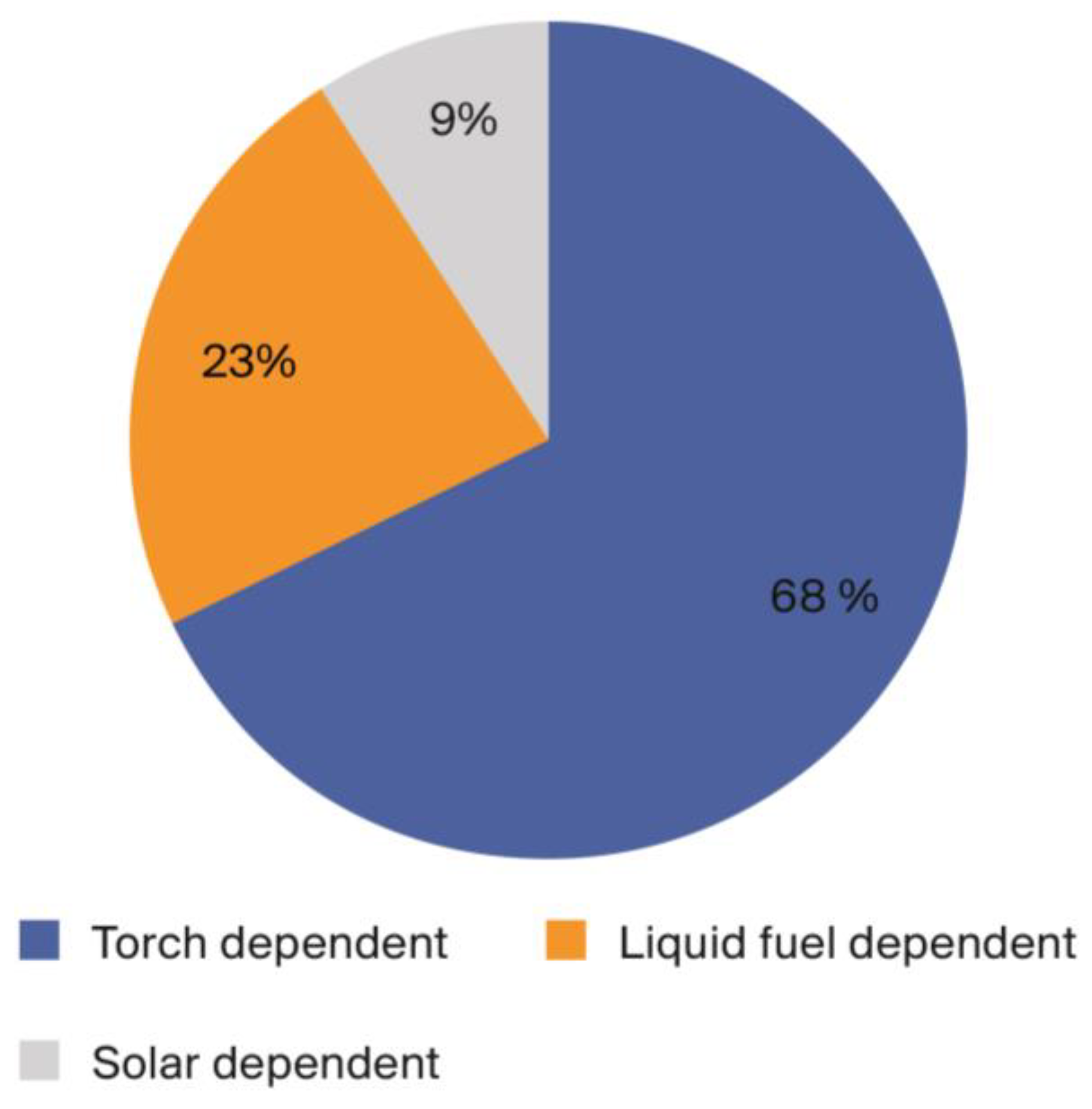
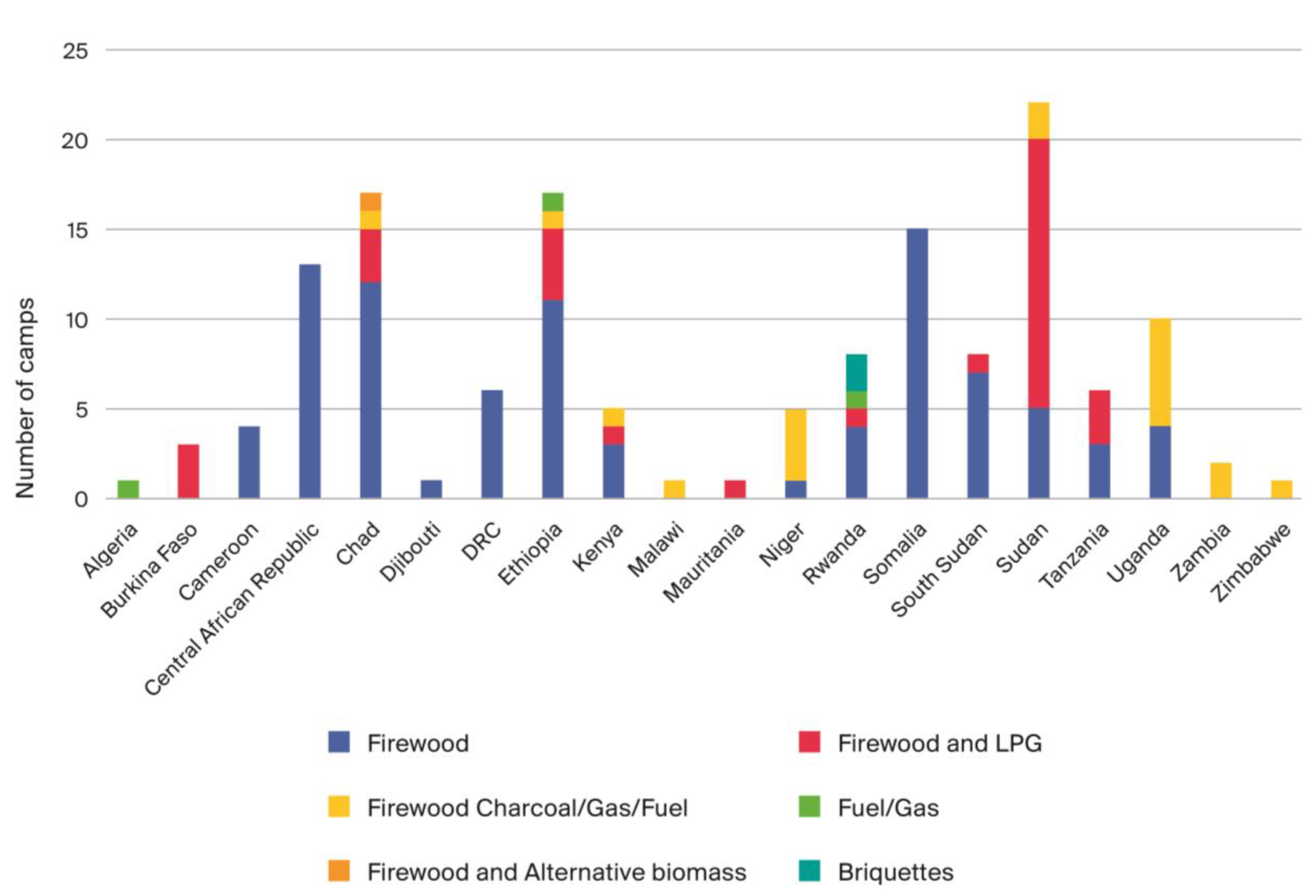
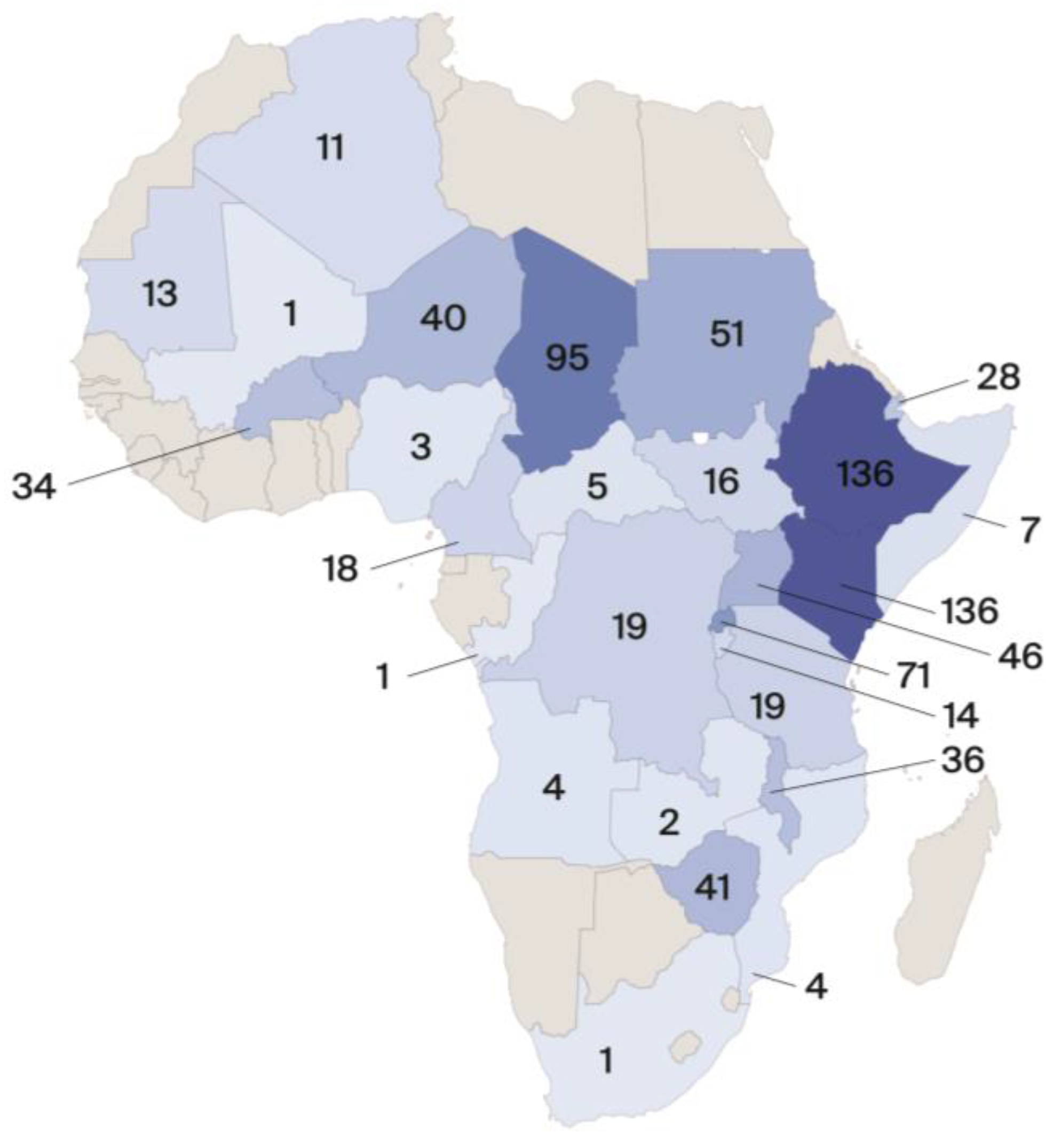
| Reference level | Information | Indicator | Source |
|---|---|---|---|
| Country | General | Energy access in rural and urban areas | [57] |
| Regulations and policies for energy access | [61] | ||
| Specific to the displacement context | Electricity access for displaced persons | [58] | |
| Access to clean cooking for displaced persons | |||
| Access to lighting for displaced persons | |||
| Number of projects | [56] | ||
| Settlement or camp | Specific to the displacement context | Camp population | [56,58,59] |
| Electricity access for displaced persons | [56] | ||
| Access to clean cooking for displaced persons | [56,58] | ||
| Access to lighting for displaced persons | [58] | ||
| Livelihood | [56] |
Disclaimer/Publisher’s Note: The statements, opinions and data contained in all publications are solely those of the individual author(s) and contributor(s) and not of MDPI and/or the editor(s). MDPI and/or the editor(s) disclaim responsibility for any injury to people or property resulting from any ideas, methods, instructions or products referred to in the content. |
© 2024 by the authors. Licensee MDPI, Basel, Switzerland. This article is an open access article distributed under the terms and conditions of the Creative Commons Attribution (CC BY) license (http://creativecommons.org/licenses/by/4.0/).





